
In just 48 hours, you can experience the essence of this UNESCO World Heritage city—once the capital of the Inca Empire and now a gateway to the Sacred Valley and Machu Picchu. From exploring historic landmarks and artisan workshops to savoring traditional Andean flavors, this guide will help you make the most of a whirlwind two-day adventure in one of South America’s most fascinating cities.
Start your journey at Cusco’s iconic Plaza de Armas (main square), the historic and cultural heart of the city. Surrounded by stunning colonial architecture and ancient Inca sites, this central square offers a perfect introduction to Cusco’s rich history.
Take in the beauty of the Cathedral and the Church of La Compañía de Jesús, or simply relax on a bench and watch the lively atmosphere unfold around you. Whether you're admiring the colonial architecture or people-watching, this is the ideal starting point to explore the city.
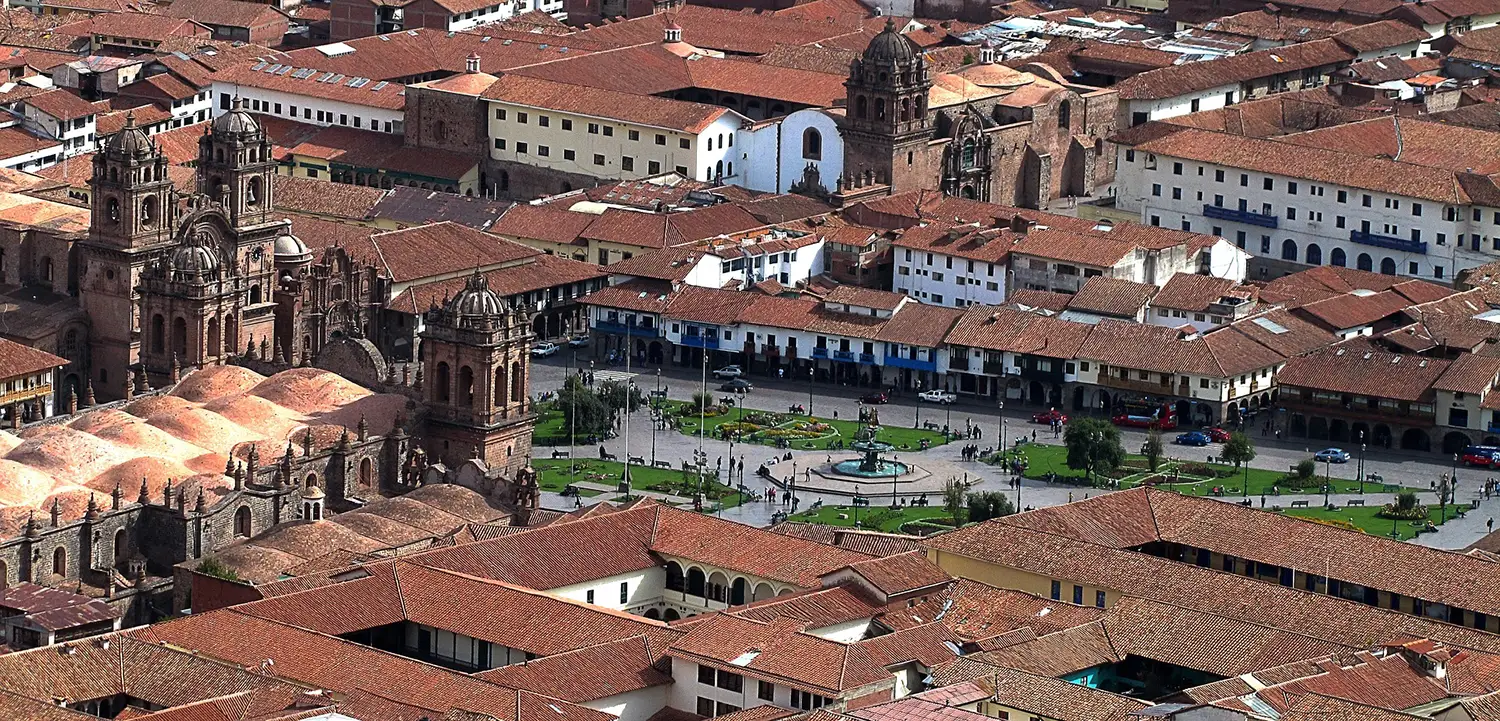
Vibrant and historic, Cusco's Plaza de Armas captures the essence of the ancient Inca capital, surrounded by colonial architecture and Andean charm. Photo by alfcermed on Pixabay .
Stroll through the bustling San Pedro Market to dive into Cusco’s vibrant local culture. Here, you'll encounter an array of traditional flavors, from exotic fruits to Andean cheeses and fresh breads.
Browse colorful stalls filled with handcrafted souvenirs, textiles, and other treasures unique to the region. This lively market is the perfect spot to taste authentic Peruvian snacks, pick up gifts, and experience the daily rhythm of local life.
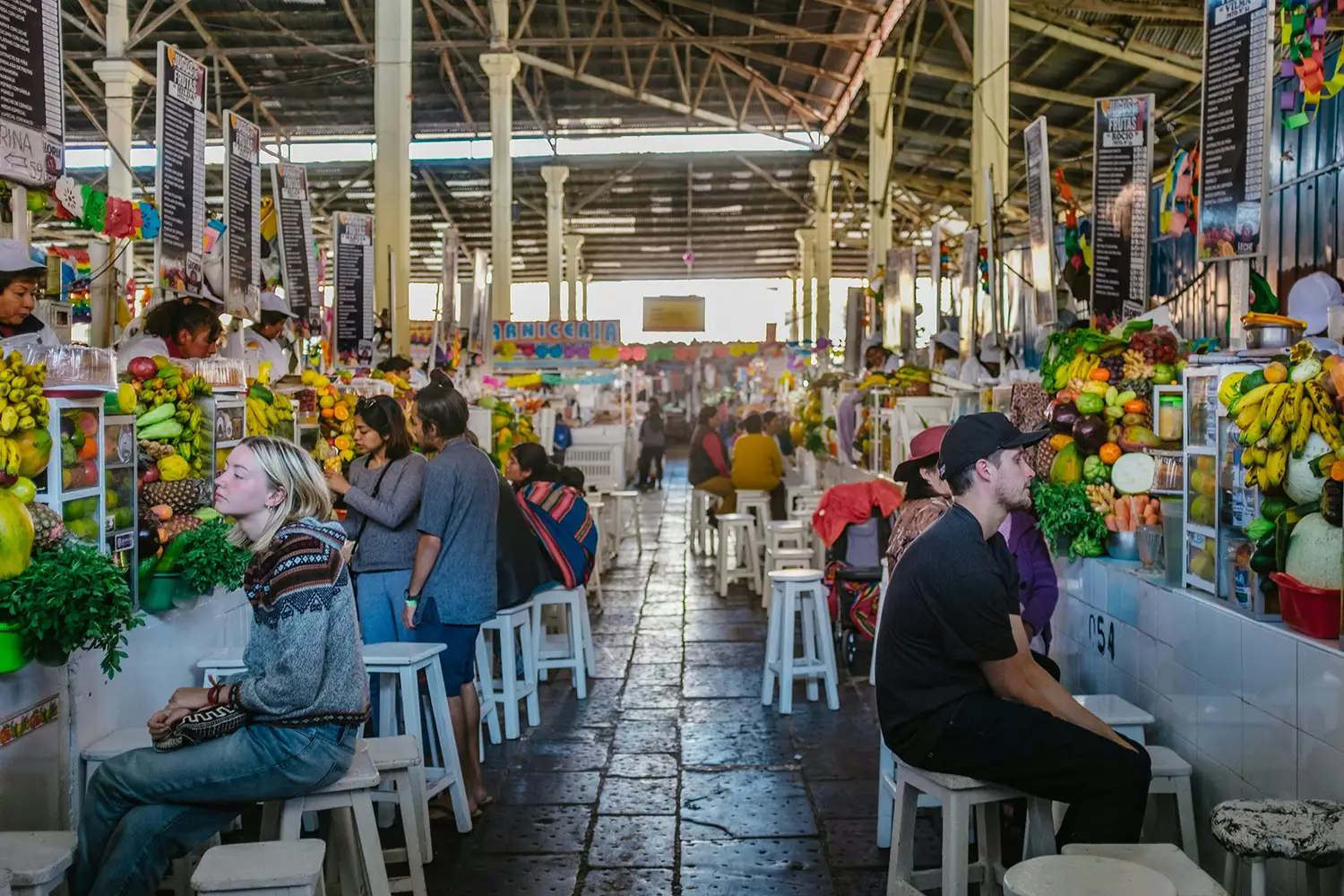
Immersed in local flavors and colors at San Pedro Market, where Cusco's rich culture comes alive with every stall. Photo by Ashim D’Silva, under the CC0 license , via Wikimedia Commons .
Explore Cusco’s rich history by journeying through the ancient Inca sites of Sacsayhuamán, Q’enqo, Puka Pukara, and Tambomachay.
Begin at Sacsayhuamán, a massive ancient fortress perched on a hill overlooking the city that was constructed by the Incas with impressive engineering and craftsmanship. Known for its enormous stones—some weighing over 100 tons—that fit together without mortar, Sacsayhuamán is a marvel of Inca ingenuity.
A walk through this UNESCO World Heritage site reveals much about the significance of the structure, which likely served both military and ceremonial purposes. You can explore its zigzagging walls, take in sweeping views of Cusco below, and imagine the grand Inti Raymi (Festival of the Sun) celebrations that still take place here annually.
Early morning or late afternoon visits are ideal for capturing the site’s peaceful beauty and photographing it under softer light.
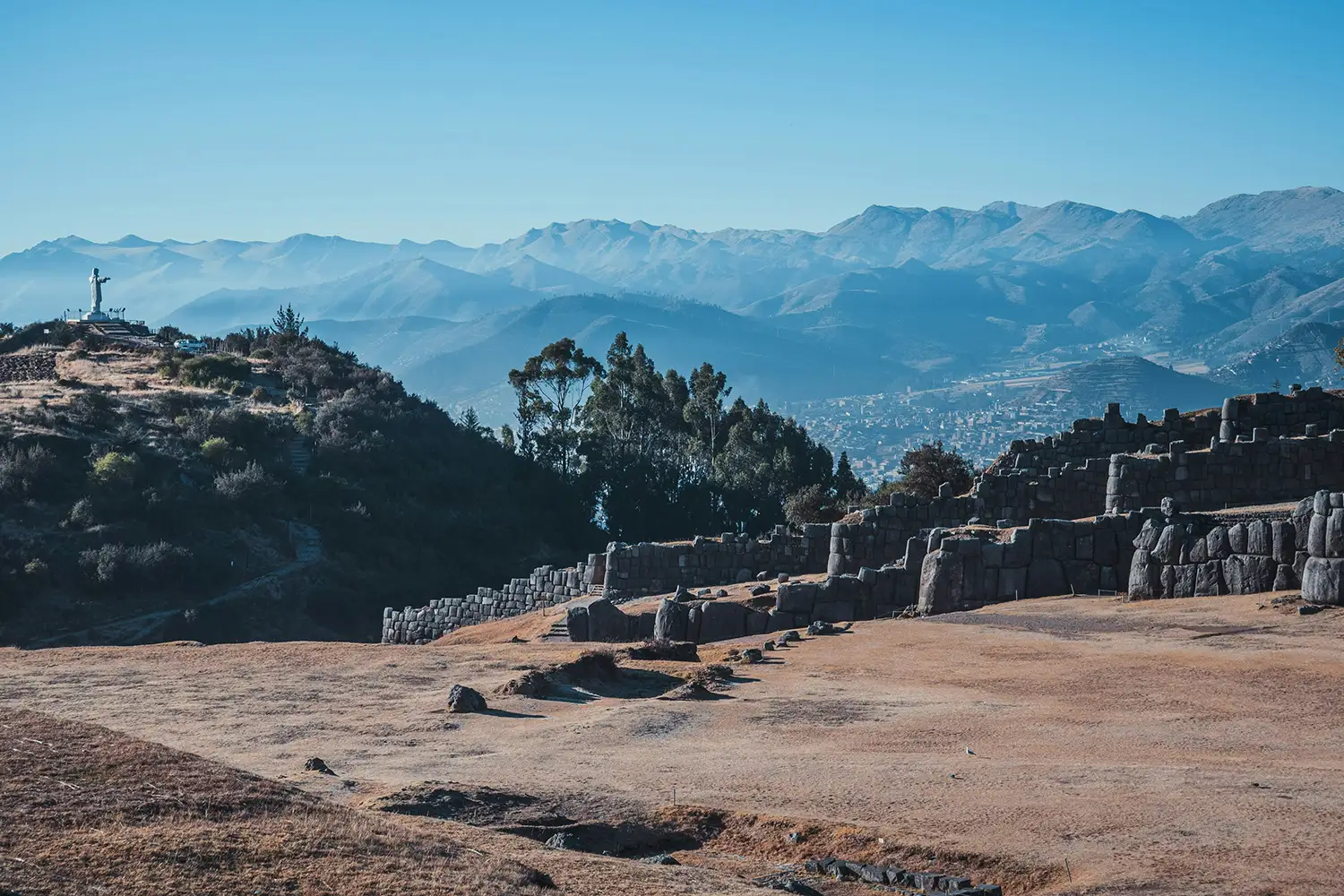
Standing strong above Cusco, the ancient fortress of Sacsayhuamán showcases the incredible stonework and ingenuity of the Inca Empire. Photo by Ruben Hanssen on Unsplash .
Continue to Q’enqo, which offers a fascinating glimpse into Inca spirituality and ritual practices. Located just a short distance from Sacsayhuamán, this enigmatic archaeological site is thought to have served as a ceremonial center, where the Incas performed sacrifices and other religious rites.
The word Q'enqo means “zigzag” in Quechua, likely referring to the intricate series of carved channels and tunnels winding through its large limestone rock formations. One of the site's most intriguing features is the stone altar, believed to have been used for offerings, which lies hidden inside a natural cave.
Walking through the cool, shaded passageways, you can almost imagine the sacred ceremonies that took place here.
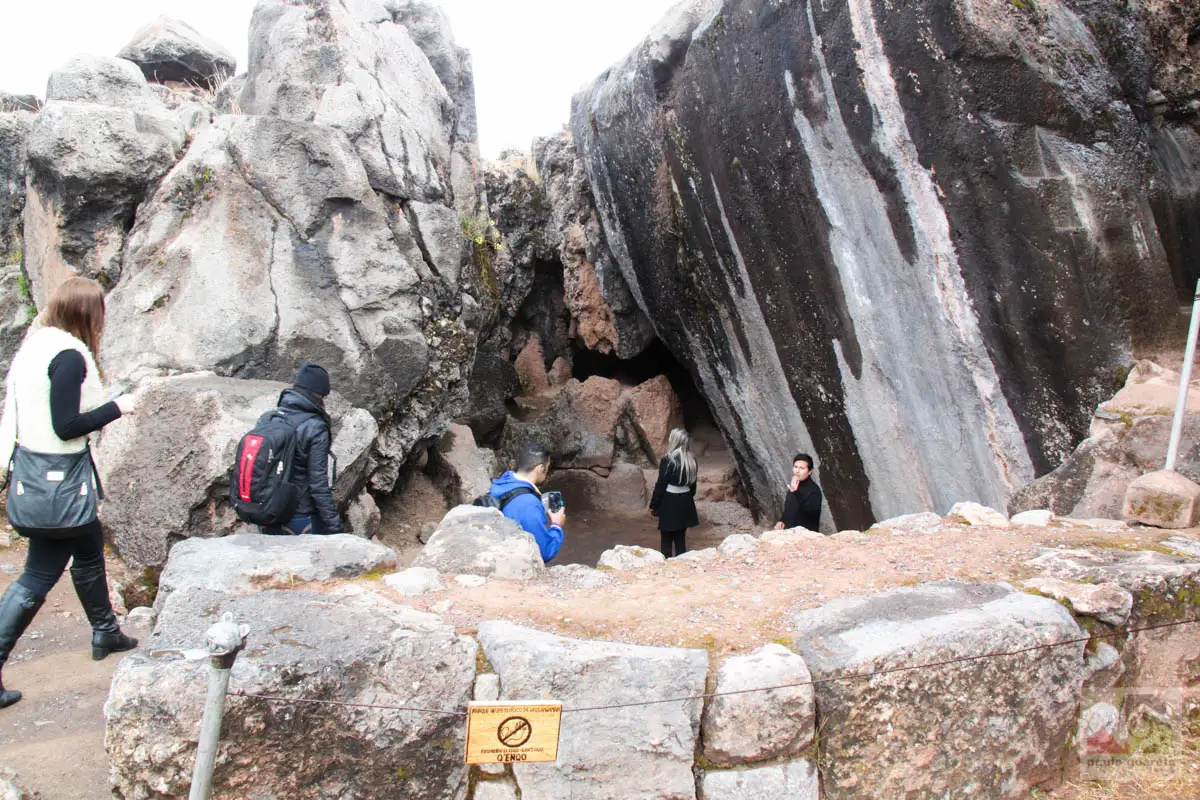
Explore the mysterious stone carvings and passageways of Q’enqo, a sacred Inca site rich in history and ancient rituals. Photo by Paulo Guereta from São Paulo, under the CC BY 2.0 < https://creativecommons.org/licenses/by/2.0 > license, via Wikimedia Commons .
Next, head to Puka Pukara, often called the "Red Fortress" due to the reddish hue of its stones at sunset, which is a must-visit for anyone exploring the ancient sites surrounding Cusco.
Located along the route to Tambomachay, this small but impressive structure is believed to have served as a military post, resting spot, or checkpoint for travelers in Inca times. With its multiple terraces, rooms, and strategic vantage point overlooking the surrounding valleys, Puka Pukara likely played an essential role in safeguarding Cusco and monitoring the flow of people and goods.
While exploring, take a moment to enjoy the beautiful Andean landscape stretching out below—a perfect backdrop to imagine the bustling activity that once took place here.
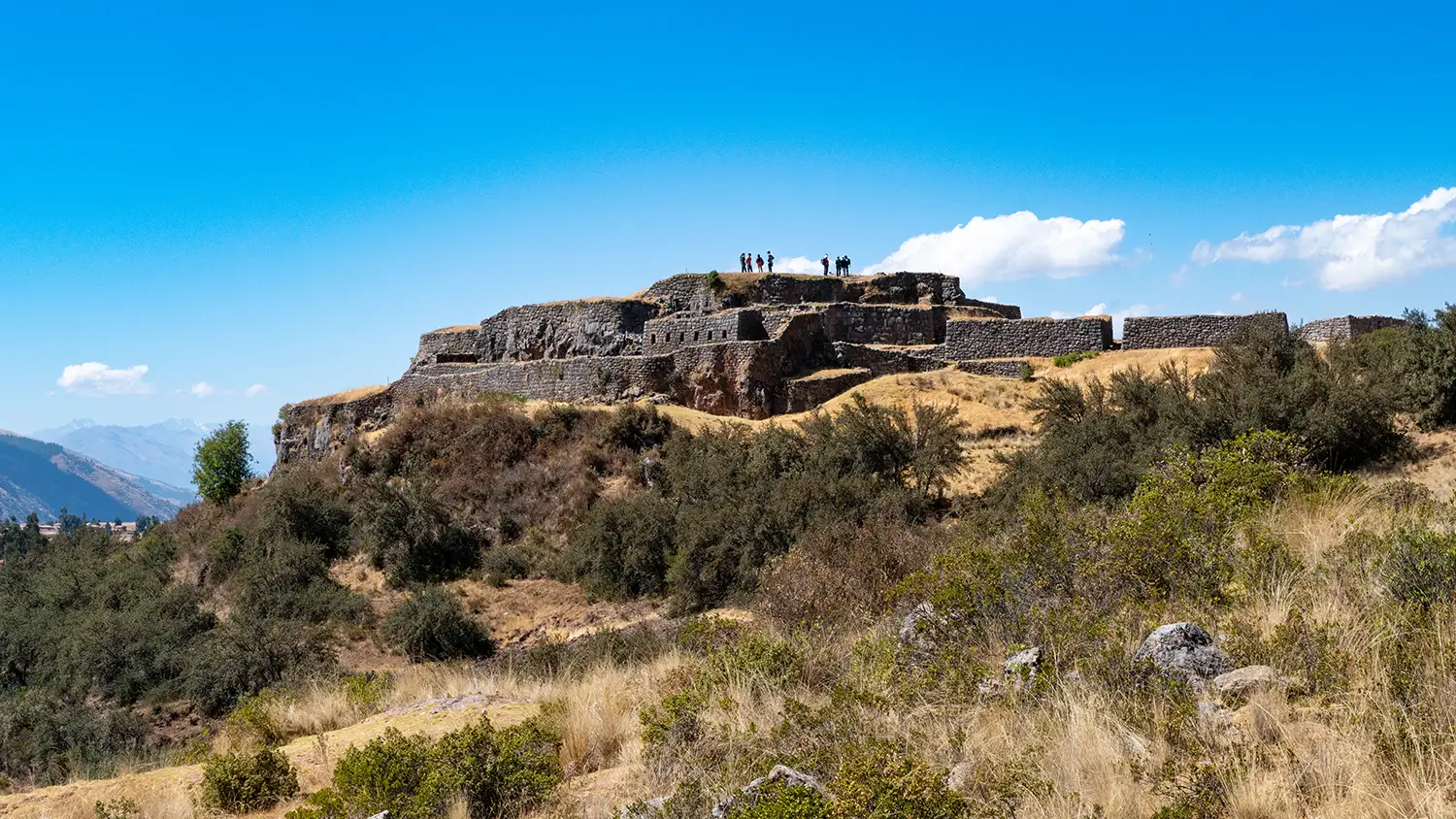
Unveiling the secrets of Puka Pukara, an Inca military site offering panoramic views of the surrounding landscapes. Photo by Christoph Strässler, under the CC BY-SA 2.0 < https://creativecommons.org/licenses/by-sa/2.0 > license, via Wikimedia Commons .
Complete your tour at Tambomachay, often known as "El Baño del Inca" or "The Bath of the Inca," an enchanting site that showcases the Inca's masterful engineering and deep reverence for water.
Situated a short distance from Puka Pukara, Tambomachay consists of a series of aqueducts, canals, and waterfalls skillfully carved into the rocks, channeling fresh mountain water through the structure. This ceremonial site is believed to have been a place dedicated to the worship of water, which held great spiritual significance for the Incas.
Tambomachay’s peaceful ambiance and continuous flow of crystal-clear water create a serene atmosphere, inviting visitors to connect with nature. Take time to appreciate the artistry and precision of the stonework, as well as the ingenious irrigation systems that have allowed the water to flow continuously for centuries.
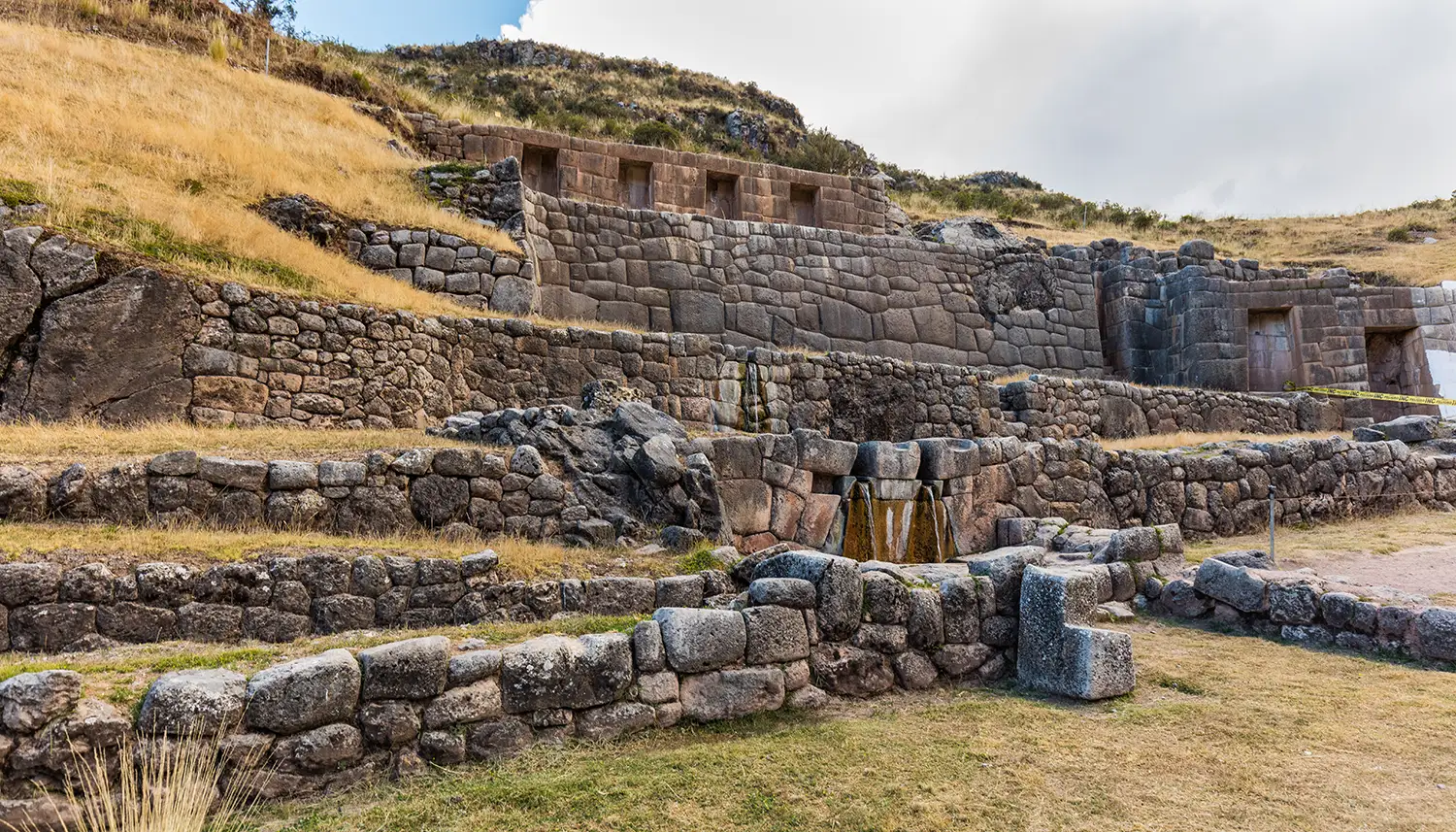
Discover the ancient beauty of Tambomachay, a serene Inca site known for its intricate water channels and spiritual significance. Photo by Diego Delso, under the CC BY-SA 4.0 < https://creativecommons.org/licenses/by-sa/4.0 > license, via Wikimedia Commons .
For an unforgettable culinary experience in Cusco, consider dining at Cicciolina, a vibrant restaurant that blends contemporary flavors with traditional Peruvian ingredients. Located near the Plaza de Armas, Cicciolina offers a cozy yet stylish ambiance, serving up dishes such as quinoa risotto, Andean trout, and creative tapas, all complemented by a selection of local wines and cocktails.
Alternatively, indulge in authentic Peruvian flavors at Chicha by Gastón Acurio, a restaurant by the renowned chef Gastón Acurio. Here, you'll find a menu celebrating the richness of Peru’s diverse regions, with standout dishes like guinea pig, ceviche, and hearty stews. The modern setting highlights the cultural heritage of Cusco while offering a sophisticated dining experience.
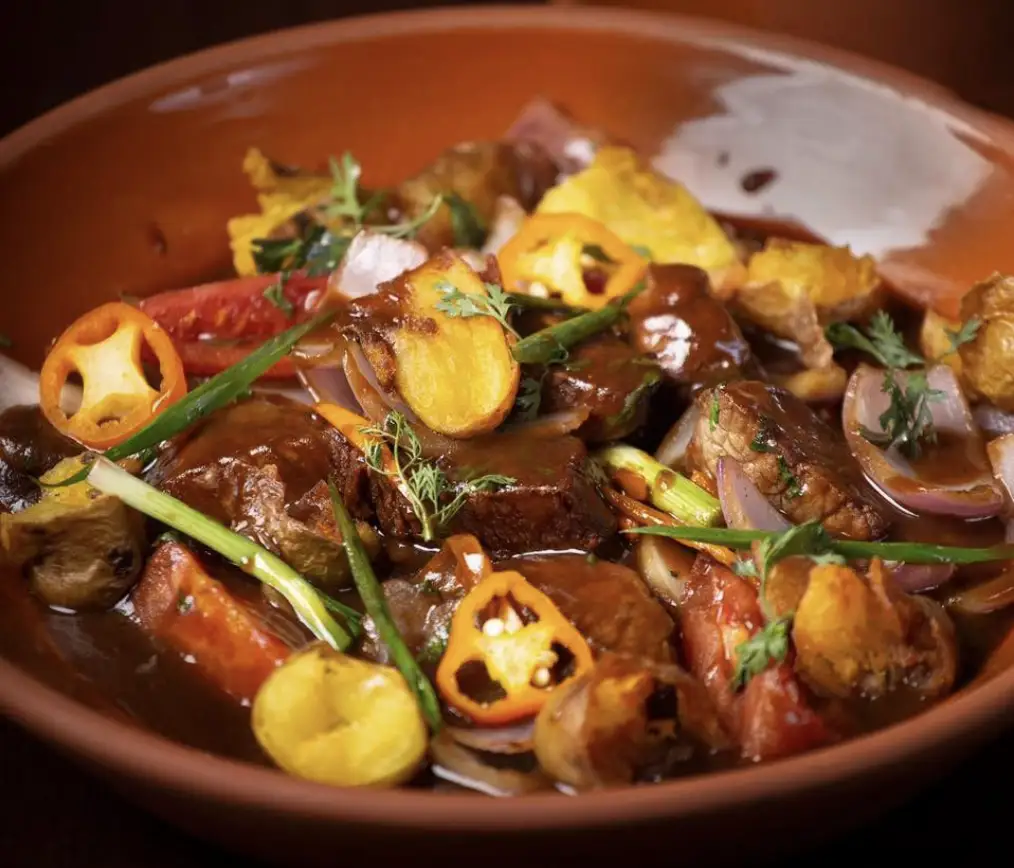
Savor the bold flavors of lomo saltado. Photo by Chicha on Instagram .
To immerse yourself in the cultural vibrancy of the region, consider attending a cultural dance show featuring traditional Andean music and folklore. Many local restaurants and venues offer performances where you can witness colorful dances and hear the sounds of traditional instruments like the charango and panpipes, enhancing your dining experience with a deeper connection to Cusco's rich cultural heritage.
In Cusco, there are several excellent places where you can experience traditional cultural dance shows, showcasing the rich Andean heritage. Here are some of the best spots:
Each of these venues offers a unique way to experience the colorful and lively traditions of Cusco’s cultural heritage.
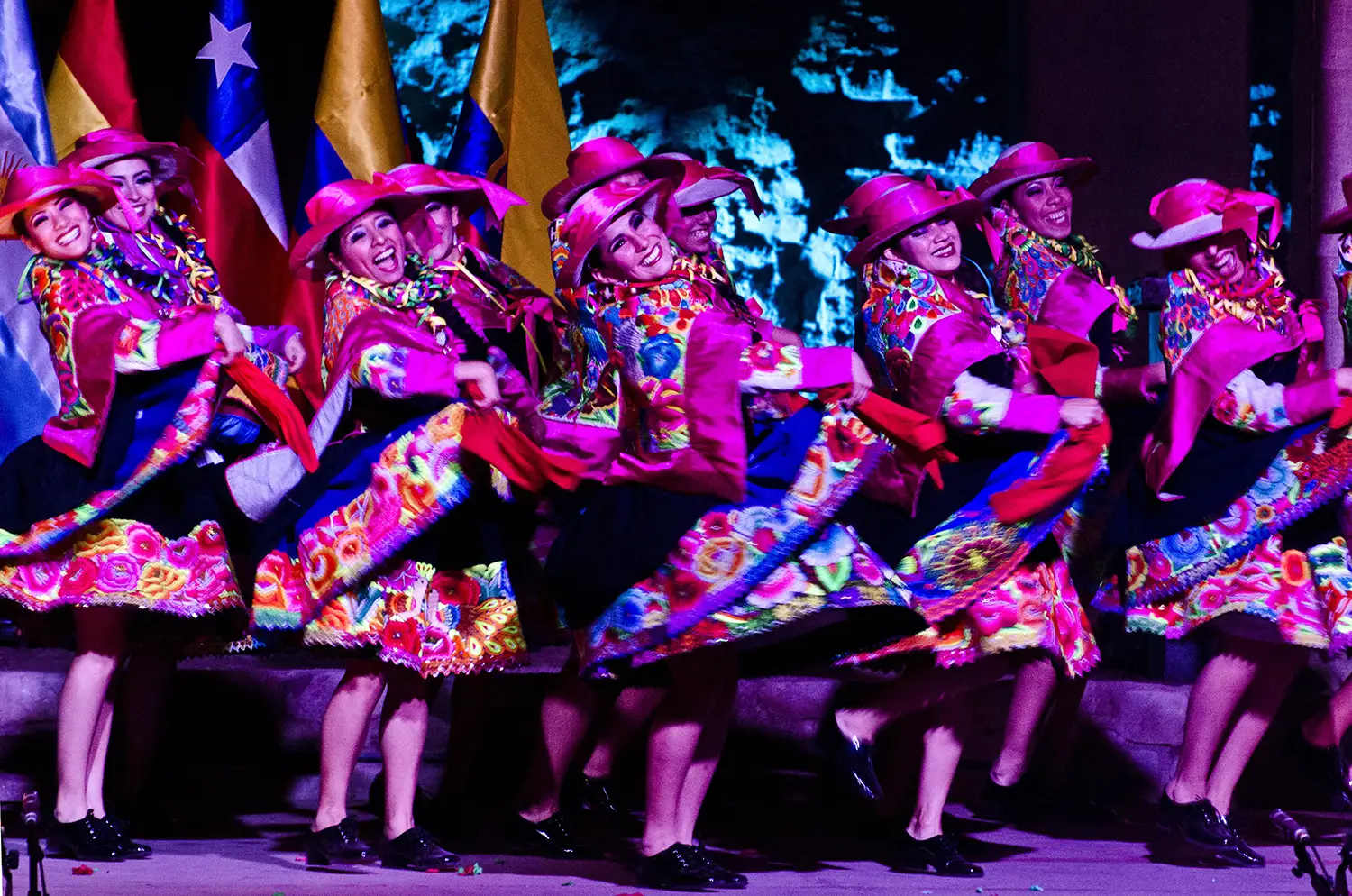
The vibrant Huaylas dance, a colorful expression of Andean culture and tradition. Photo by Secretaría de Cultura de la Nación, under the CC BY-SA 2.0 < https://creativecommons.org/licenses/by-sa/2.0 > license, via Wikimedia Commons .
Here are our top hotel recommendations in Cusco. Looking for more options? Click here to explore further!
Palacio del Inka, located in the heart of Cusco, offers a unique blend of colonial charm and modern luxury. This five-star hotel, part of Marriott’s Luxury Collection, is situated across from the Qorikancha Temple, providing guests with a direct connection to the city’s rich history. Housed in a 500-year-old mansion, its décor seamlessly combines traditional Peruvian elements with opulent furnishings. Guests can enjoy world-class amenities, personalized service, and an authentic cultural experience in one of the most iconic properties in Cusco.
Casa Andina Premium Cusco is a charming hotel situated in a restored 18th-century colonial mansion, offering an elegant stay just a few blocks from Cusco’s iconic Plaza de Armas. The hotel’s central location, beautifully preserved architecture, and modern comforts make it an excellent choice for travelers seeking convenience and authenticity. With cozy courtyards, tasteful décor blending Andean and colonial styles, and attentive service, this hotel creates a warm and welcoming atmosphere.
Casa Andina Premium Cusco is a charming hotel situated in a restored 18th-century colonial mansion, offering an elegant stay just a few blocks from Cusco’s iconic Plaza de Armas. The hotel’s central location, beautifully preserved architecture, and modern comforts make it an excellent choice for travelers seeking convenience and authenticity. With cozy courtyards, tasteful décor blending Andean and colonial styles, and attentive service, this hotel creates a warm and welcoming atmosphere.
Anahuarque Boutique Hotel offers an upscale and tranquil retreat in the heart of Cusco, combining modern luxury with traditional Andean design. Located near the city center, the hotel is a short distance from Plaza de Armas, making it convenient for exploring Cusco's historic landmarks and vibrant markets. With its intimate ambiance, personalized service, and a focus on sustainability, Anahuarque provides a peaceful haven for travelers who seek comfort and style, while staying connected to the cultural essence of the city.
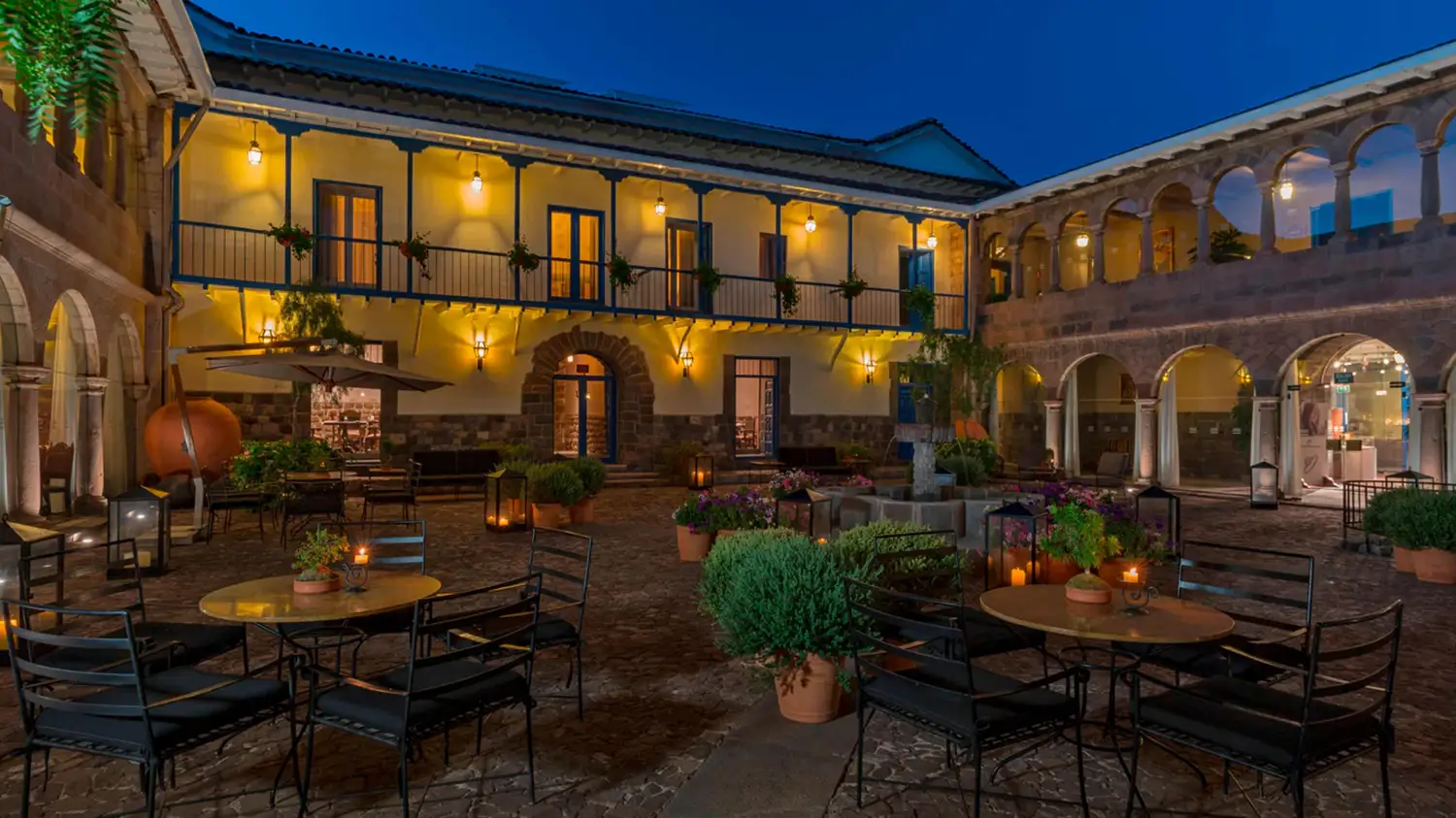
Step into the enchanting courtyard of Palacio del Inka, where history meets luxury in the heart of Cusco. Photo by Palacio del Inka, a Luxury Collection Hotel, Cusco .
Cusco Tours:
For an enriching day trip from Cusco, head to the Sacred Valley and visit either Pisac or Ollantaytambo—both offering incredible Inca ruins, breathtaking terraces, and charming villages.
In Pisac, explore a stunning archaeological site with sweeping mountain views, intricate agricultural terraces, and a vibrant town market filled with local crafts and produce. The Pisac ruins are perched high above the valley, offering insight into ancient Inca urban planning and religious sites.
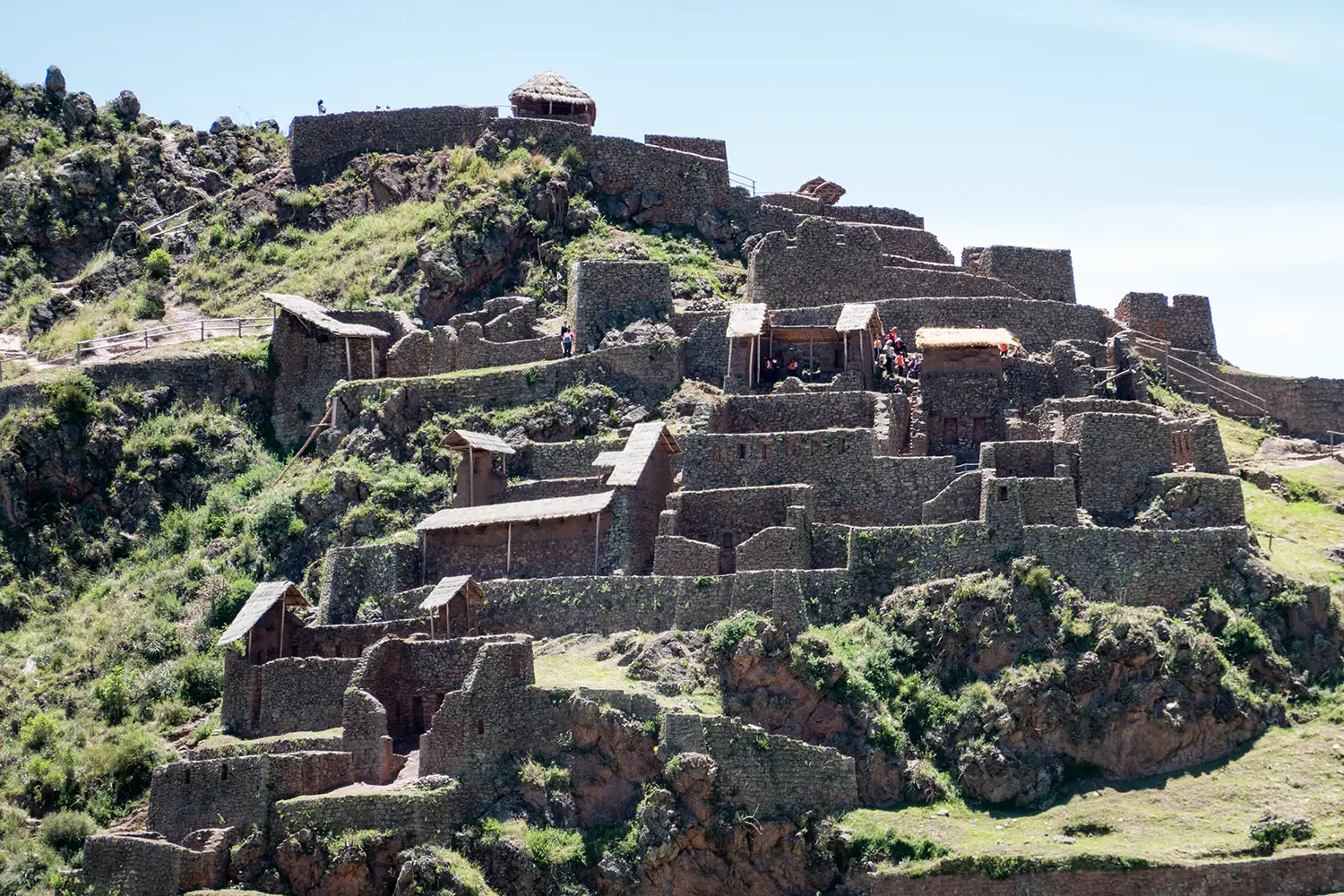
Explore the Pisac ruins, where expansive Inca terraces and ancient stonework overlook the Sacred Valley, blending history with breathtaking views. Photo by PsamatheM, under the CC BY-SA 4.0 < https://creativecommons.org/licenses/by-sa/4.0 > license, via Wikimedia Commons .
Alternatively, Ollantaytambo is known for its impressive fortress ruins and well-preserved Inca town, with original stone streets and canals. It also serves as a gateway to Machu Picchu, so it’s a great option if you’re planning to continue your journey into the heart of Inca history. Both towns provide a glimpse into traditional Andean life, making either destination an ideal choice for a Sacred Valley adventure.
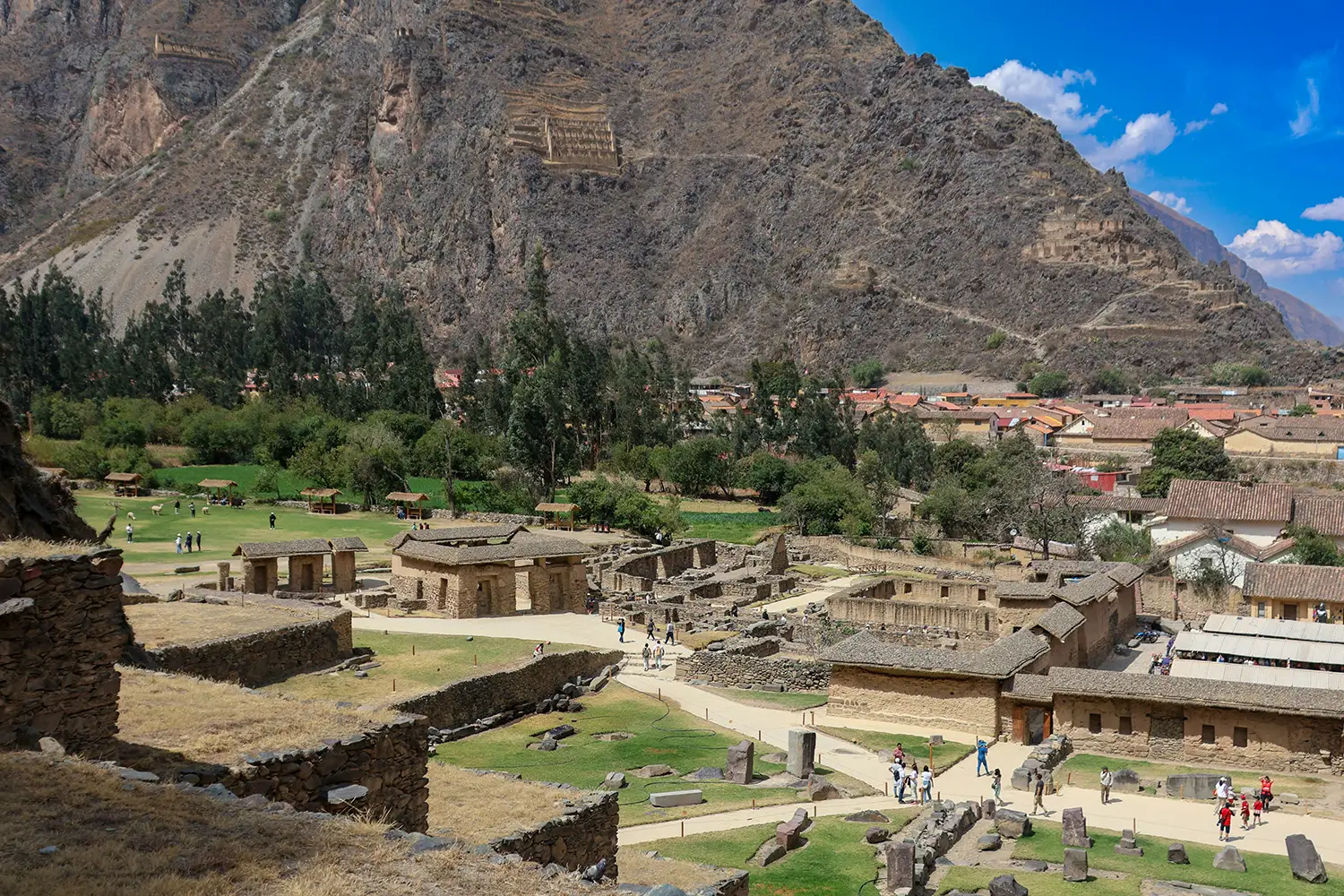
Ollantaytambo, a living Inca town with majestic stone terraces, ancient ruins, and cobblestone streets that transport you back in time. Photo by Meg von Haartman on Unsplash .
Immerse yourself in Cusco’s rich cultural heritage by joining a workshop that connects you directly with traditional Andean arts. From pottery and textile weaving to cooking classes, Cusco’s cultural workshops offer hands-on experiences that let you delve deeper into Peruvian culture. These workshops not only support local artisans and preserve cultural traditions but also provide meaningful and memorable experiences of Andean life.
Weaving and textile workshops in Cusco offer an intimate look at the Andean weaving tradition, a craft that has been a vital part of local culture for centuries. These workshops, held by skilled artisans, provide hands-on experiences where you can learn traditional techniques, from spinning alpaca wool to using natural dyes made from plants and insects.
Many workshops take place at centers like the Centro de Textiles Tradicionales del Cusco , where you’ll meet Quechua-speaking weavers who demonstrate each step of the process. They’ll show you how to create intricate patterns and designs that reflect Andean symbols, nature, and cosmology.
Participating in a weaving workshop not only gives you a chance to create a piece of textile art but also supports indigenous communities and keeps these valuable traditions alive.
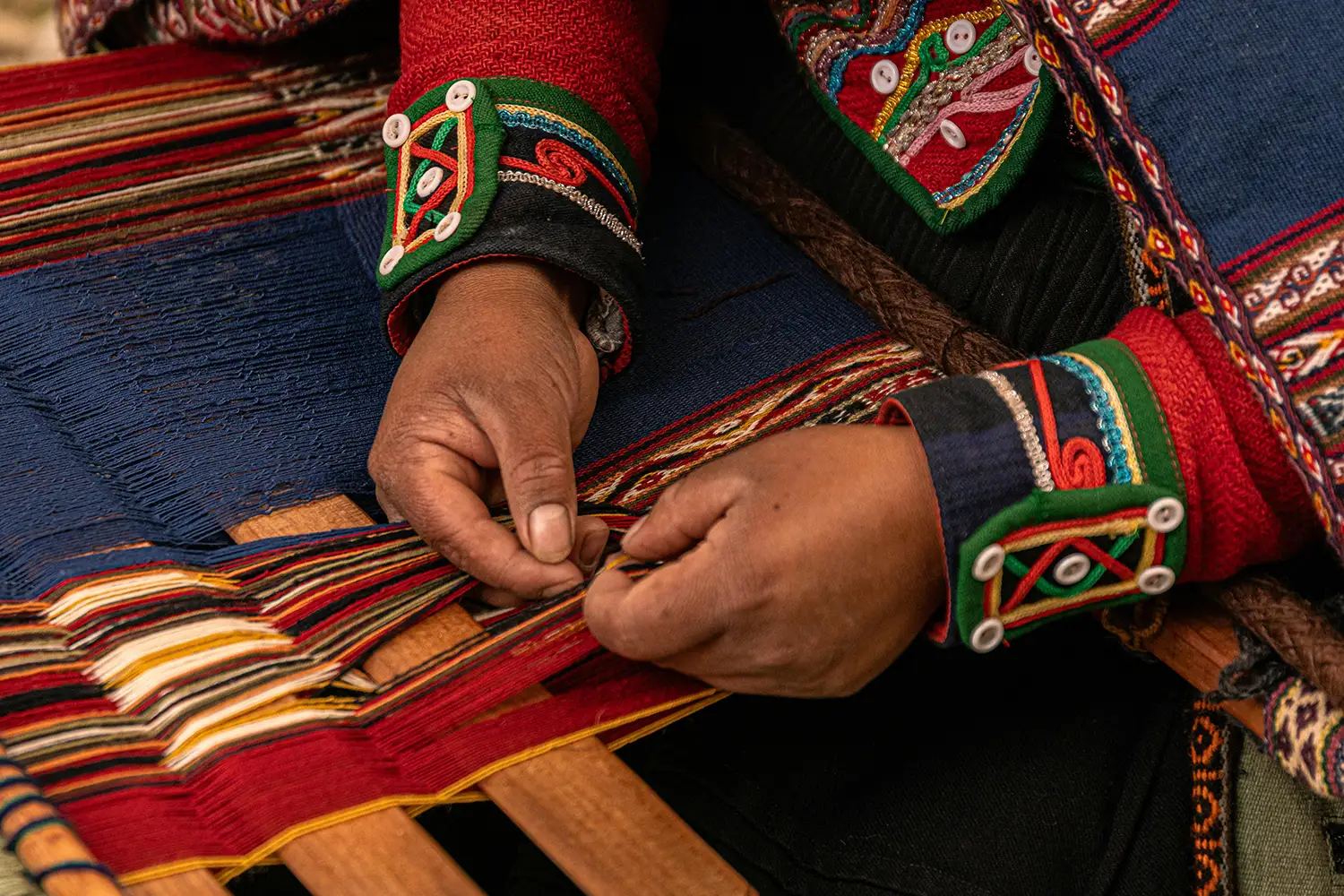
Discover the art of weaving in Cusco, where vibrant threads and ancient techniques come together to create timeless masterpieces. Photo by Joel Alencar on Pexels .
Pottery and ceramics workshops in Cusco are a fantastic way to connect with Peru's ancient artisanal traditions. In these workshops, you’ll learn techniques that date back to pre-Incan civilizations, from shaping clay into traditional forms to painting and finishing with natural pigments. Guided by local ceramic artists, you'll explore the unique Andean style, often marked by symbolic motifs inspired by nature, mythology, and daily life.
Studios, like Cerámica Seminario offer classes where you can create your own pieces, whether a small vase, bowl, or decorative item. These hands-on experiences allow you to bring home a unique souvenir while supporting local artists and preserving a cherished cultural practice.
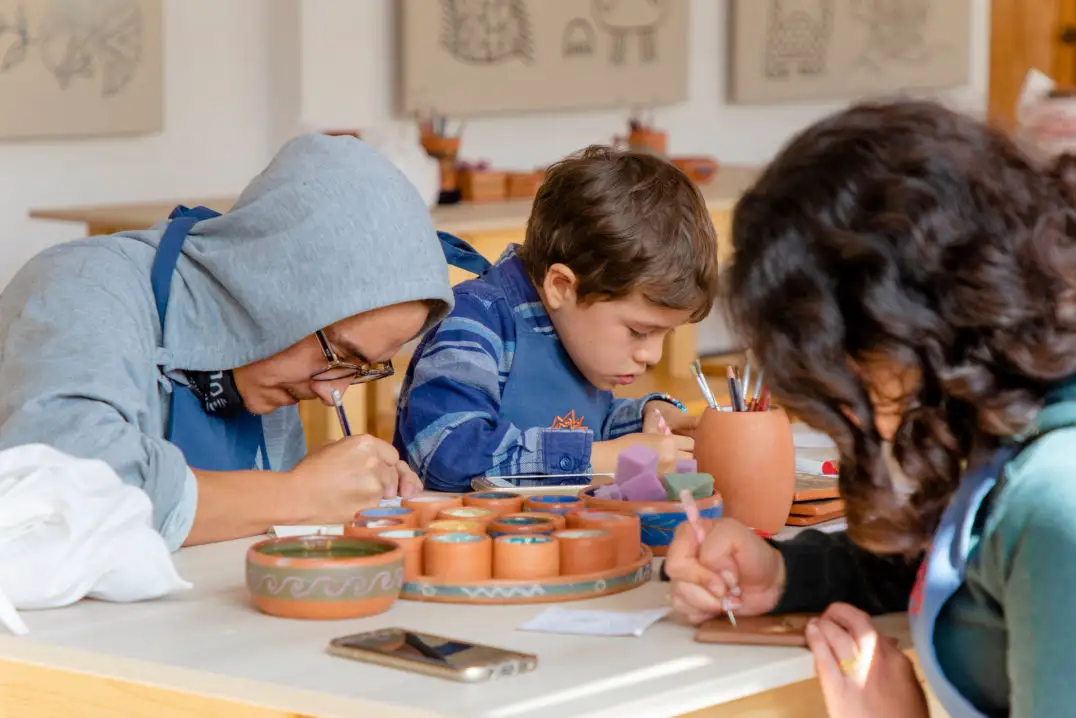
Uncover the rich tradition of pottery and ceramics in Cusco, where you'll transform clay into beautiful works of art. Photo by Cerámica Seminario .
Peruvian cooking classes in Cusco offer a flavorful dive into the country’s world-famous culinary scene. These hands-on classes let you discover Peru’s rich heritage of ingredients and cooking techniques, learning to make popular Peruvian dishes.
Classes often begin with a tour of a local market, such as San Pedro Market, where you'll learn about unique Andean ingredients, from fresh herbs and exotic fruits to the hundreds of potato varieties. Guided by experienced local chefs, you'll then dive into preparing a multi-course meal, picking up tips on traditional techniques, presentation, and even Peruvian cocktail-making, like crafting the perfect Pisco Sour. Cusco Culinary and Ivanna Lescano Cooking Class, among others, provides an immersive experience in Peruvian cuisine.
Whether you're a beginner or a seasoned cook, these classes provide a fun, interactive way to learn about Peruvian food and culture, with a delicious reward at the end.
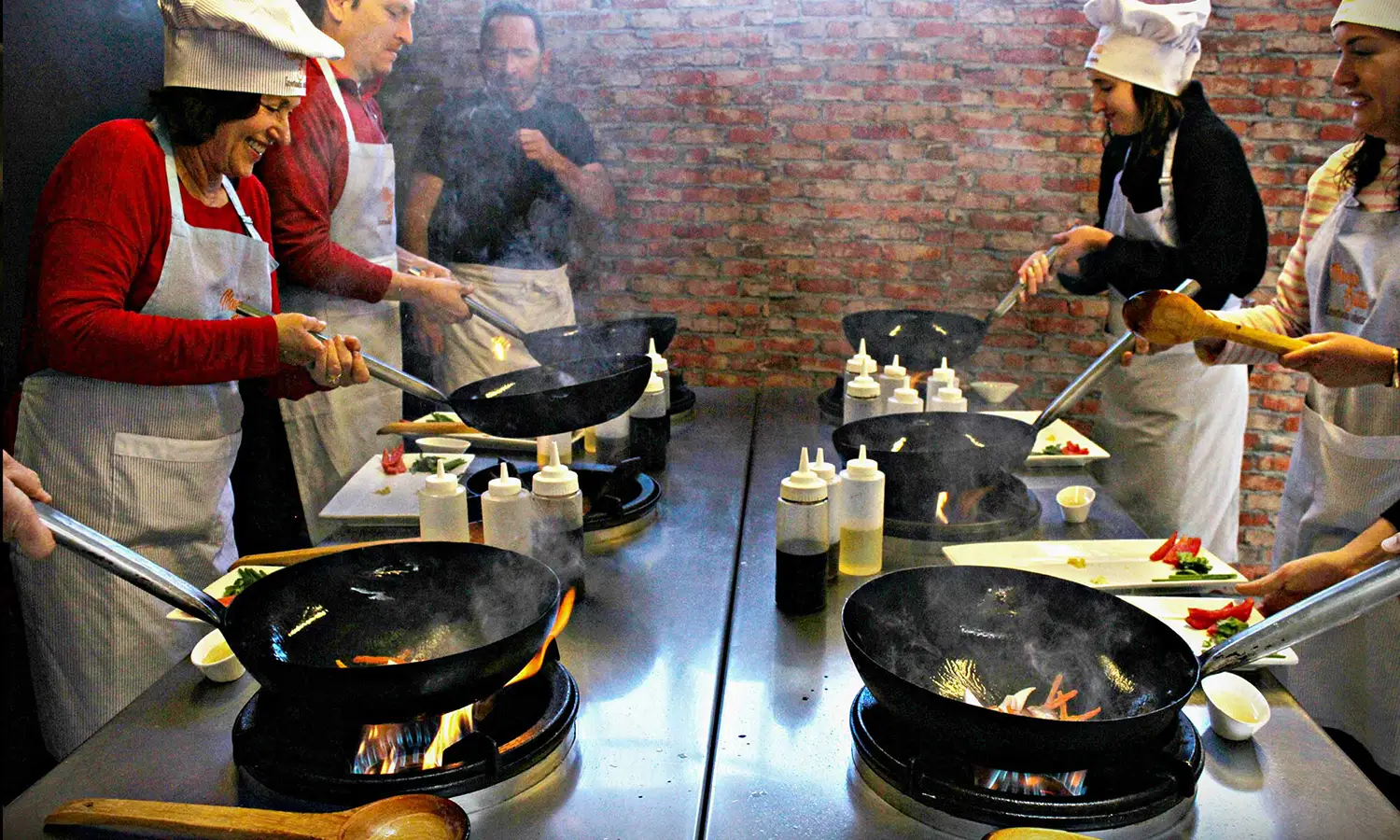
Hands-on with Peruvian flavors in a Cusco cooking class, where local ingredients and traditional recipes come to life. Photo by Ivanna Lescano Cooking Class .
A traditional Andean dance or music workshop in Cusco offers a vibrant and immersive experience into the heart of Peru's rich cultural heritage. Whether you're learning the energetic Huayno dance, which is characterized by its lively steps and colorful costumes, or exploring the rhythms of traditional instruments like the charango (a small guitar-like string instrument) or zampoña (panpipes), these workshops bring the Andean culture to life.
In a dance workshop, you'll not only learn the steps to a traditional Andean dance but also gain insight into its cultural significance—many dances are tied to ancient rituals, celebrations, and the changing seasons. Music workshops offer an opportunity to play traditional instruments, with expert musicians guiding you through the unique sounds that have echoed through the Andes for centuries. Both workshops are often accompanied by a brief cultural talk, explaining the significance of the music and dance in Andean life.
It's a perfect way to connect with the local culture and take home a piece of Cusco's musical and dance traditions. Studios like Qosqo Native Art Center , among others, offer these workshops.
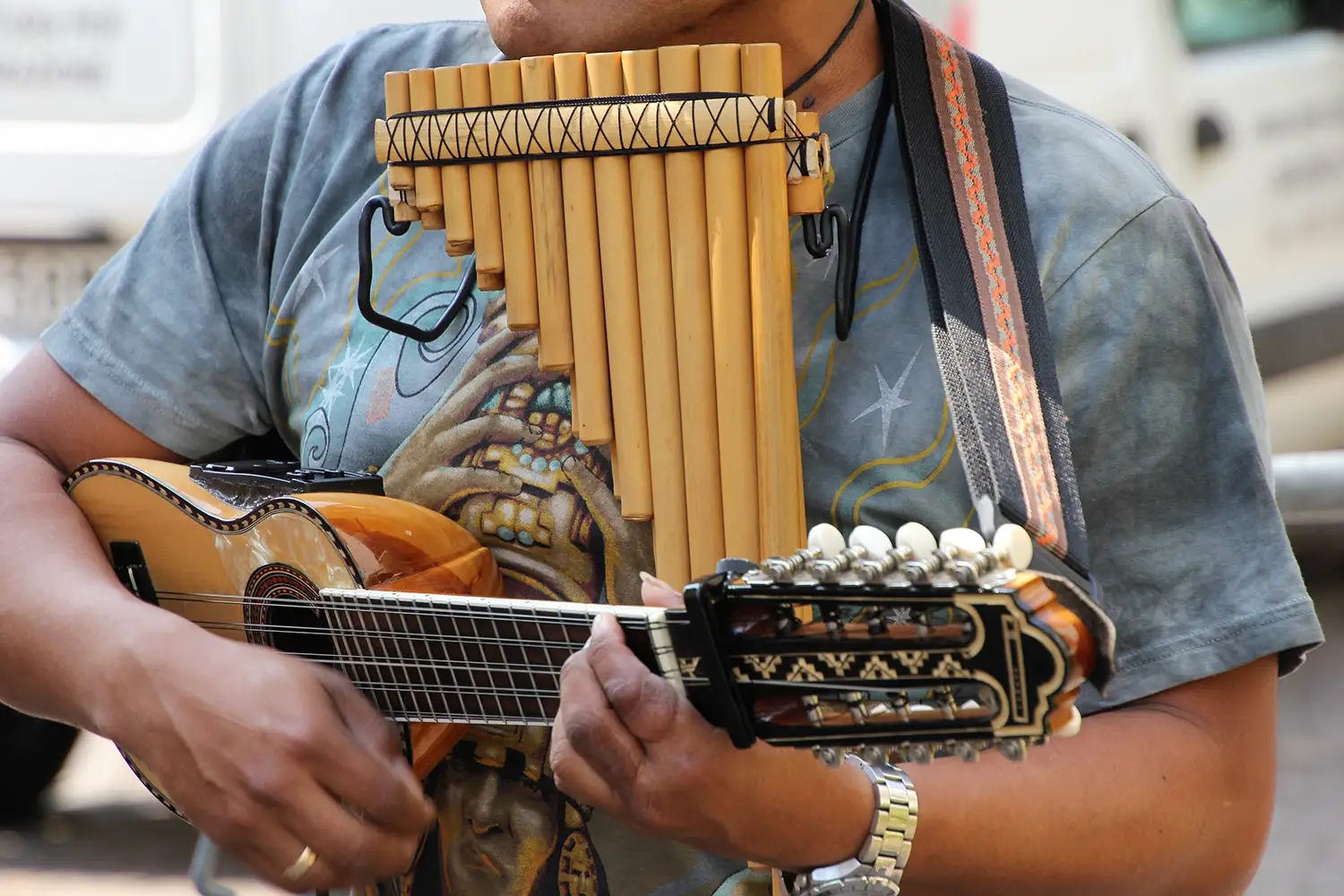
The soulful sounds of the charango and zampoña fill the Andes. Photo by Gianni Careddu, under the CC BY-SA 4.0 < https://creativecommons.org/licenses/by-sa/4.0 > license, via Wikimedia Commons .
Whether you're admiring ancient Incan relics in museums or picking up vibrant, handwoven textiles at the markets, Cusco offers endless opportunities to connect with its artistic and cultural heritage. Here’s a guide on where to go for the best museum experiences and markets for unique souvenirs:
Museo Inka in Cusco is a top destination for those eager to learn about the Inca Empire and Andean civilizations that shaped Peruvian history. Located in a beautiful colonial mansion near the Plaza de Armas, the museum offers a rich array of exhibits showcasing artifacts like textiles, ceramics, jewelry, tools, and ceremonial objects. Its collections provide a fascinating look into Inca society, including their advanced weaving, agriculture, and spiritual practices.
One of the museum's highlights is its collection of mummies, which illustrates ancient burial rituals and beliefs about the afterlife. Additionally, Museo Inka often hosts live demonstrations by skilled Q’ero weavers, bringing traditional Andean textile techniques to life. This museum not only preserves relics of the past but also provides a direct connection to the living culture of the Andes, making it an essential stop for anyone visiting Cusco. Find it here !
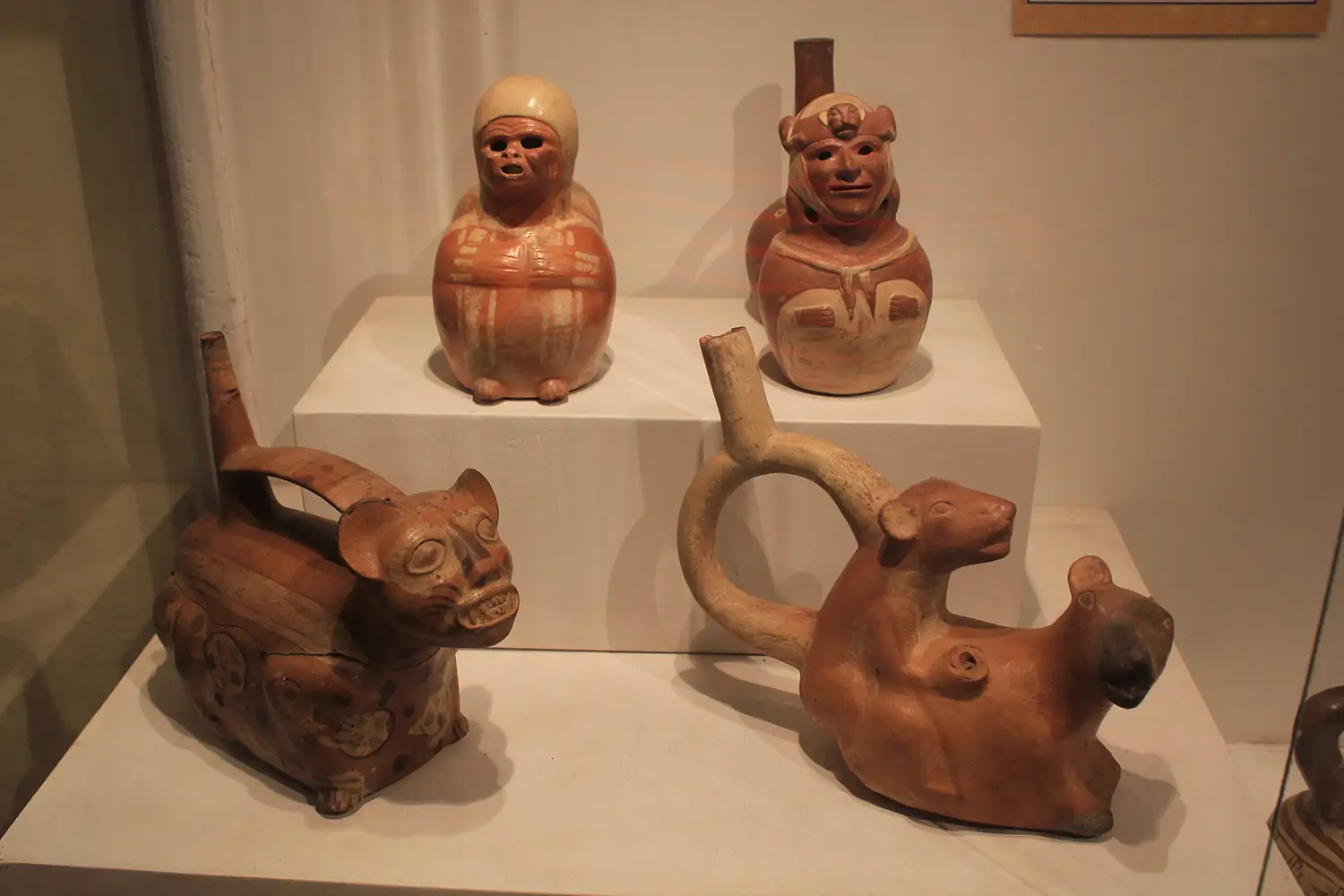
Ancient artifacts and relics reveal the incredible history and culture of the Inca Empire. Photo by Laslovarga, under the CC BY-SA 4.0 < https://creativecommons.org/licenses/by-sa/4.0 > license, via Wikimedia Commons .
Museo de Arte Precolombino (MAP) in Cusco offers a unique glimpse into the artistry and craftsmanship of ancient civilizations that once flourished in Peru and other parts of Latin America.
Housed in a beautifully restored colonial mansion, the museum showcases over 400 pieces from pre-Inca and Inca cultures, including the Moche, Nazca, Chavín, and Paracas societies. Each exhibit focuses on distinct artistic expressions, such as intricate pottery, metalwork, stone carvings, and vibrant textiles, with artifacts dating back as far as 1250 BCE.
One of the museum’s standout features is its thoughtfully curated galleries, which highlight the aesthetics and symbolic meanings behind each piece. Visitors can explore rooms dedicated to gold, silver, and wood craftsmanship, offering insight into the artistic skills that defined these civilizations. Located in the heart of Cusco’s historic district, the MAP museum is a captivating destination for those interested in Peru's ancient cultures and the legacy they left behind. Find it here !
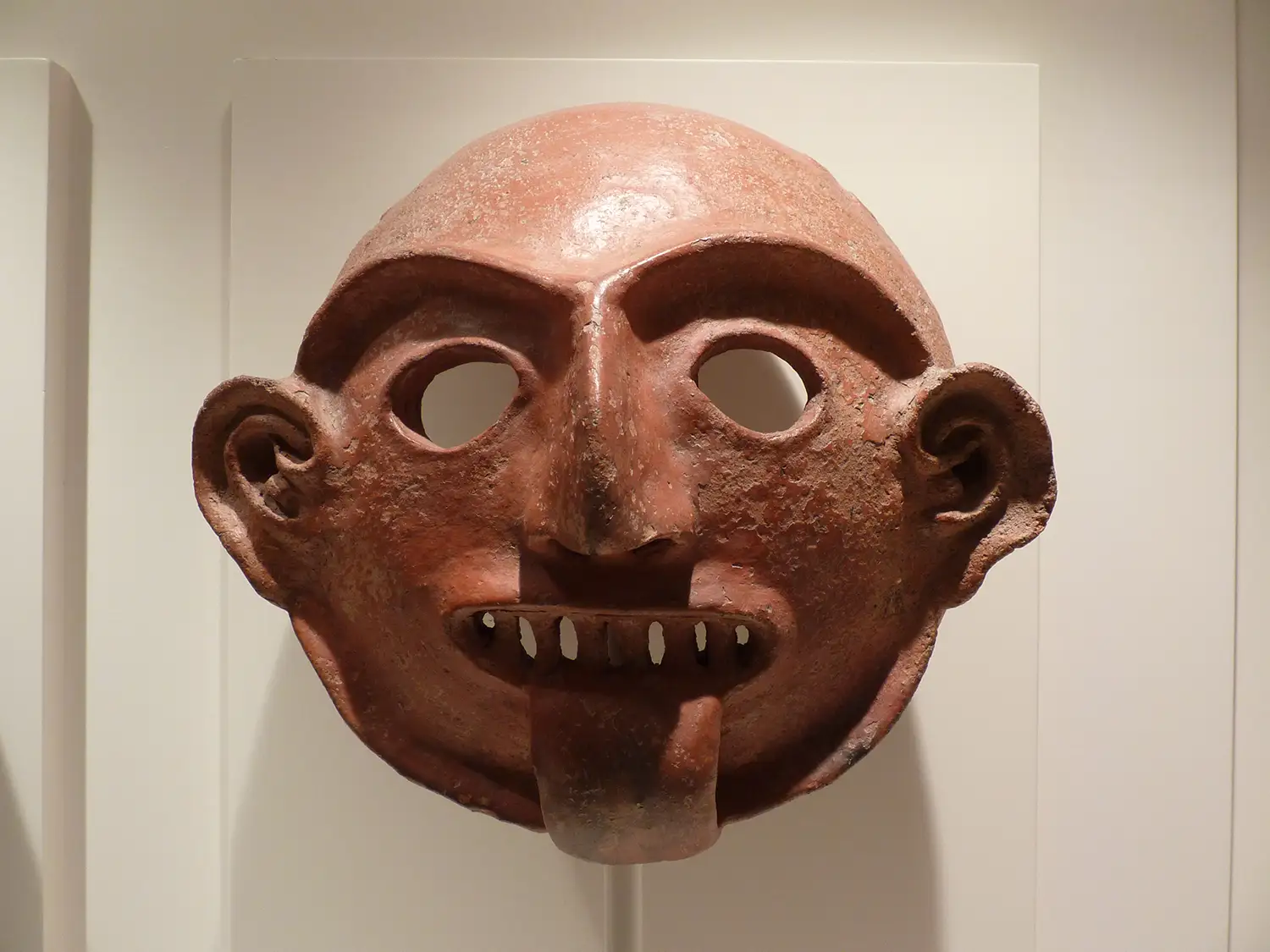
Exploring the treasures of the Museo de Arte Precolombino, where exquisite artifacts from ancient cultures tell the story of Peru’s rich pre-Columbian heritage. Photo by David Monniaux, under the CC BY-SA 3.0 < https://creativecommons.org/licenses/by-sa/3.0 > license, via Wikimedia Commons .
The Casa Concha Museum in Cusco, Peru, is a remarkable cultural site showcasing the rich history and heritage of the Inca Empire. Housed in a colonial-era mansion, the museum is part of the regional cultural landscape and is known for its fascinating collection of Inca artifacts.
Visitors can explore exhibits related to the ancient Andean civilization, including objects, textiles, and pottery. The museum also highlights the renowned Concha collection, which offers insights into the daily life and religious practices of the Inca people. Casa Concha is an essential stop for those interested in Peru’s pre-Columbian history, as it combines both Incan history and the architectural beauty of the colonial period.
If you'd like to learn more about the museum and its offerings, feel free to visit its official website or explore detailed visitor information available online. Find it here !
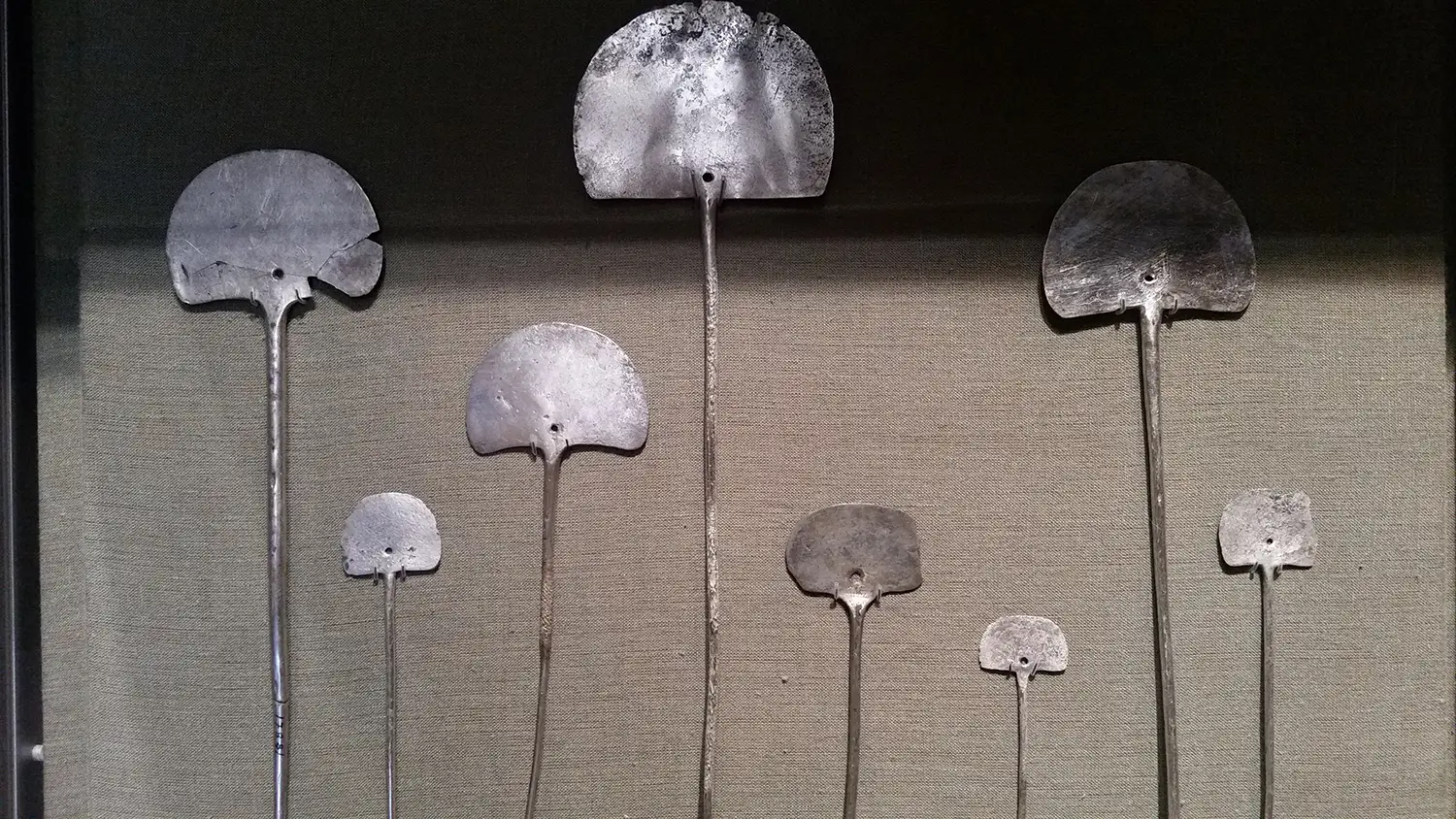
Casa Concha Museum showcases remarkable artifacts from Machu Picchu, including tools that were used by the Incas. Photo by Pi3.124, under the CC BY-SA 4.0 < https://creativecommons.org/licenses/by-sa/4.0 > license, via Wikimedia Commons .
The Centro de Textiles Tradicionales del Cusco (CTTC) is a nonprofit organization in Cusco, Peru, dedicated to preserving and promoting the traditional textile arts of the Andean region. The center collaborates with local indigenous communities to showcase their exceptional weaving techniques, which have been passed down for generations.
Visitors to the CTTC can explore a diverse collection of textiles, including handwoven garments, blankets, and tapestries, all crafted using natural dyes and time-honored methods. The center also provides educational programs, workshops, and tours that offer insights into the cultural significance of these textiles, as well as their role in local communities.
The CTTC is a key destination for those interested in Peru's indigenous cultures and the rich history of Andean craftsmanship. By supporting the CTTC, visitors contribute to the preservation of these vital traditions and ensure their continuity for future generations. Find it here !
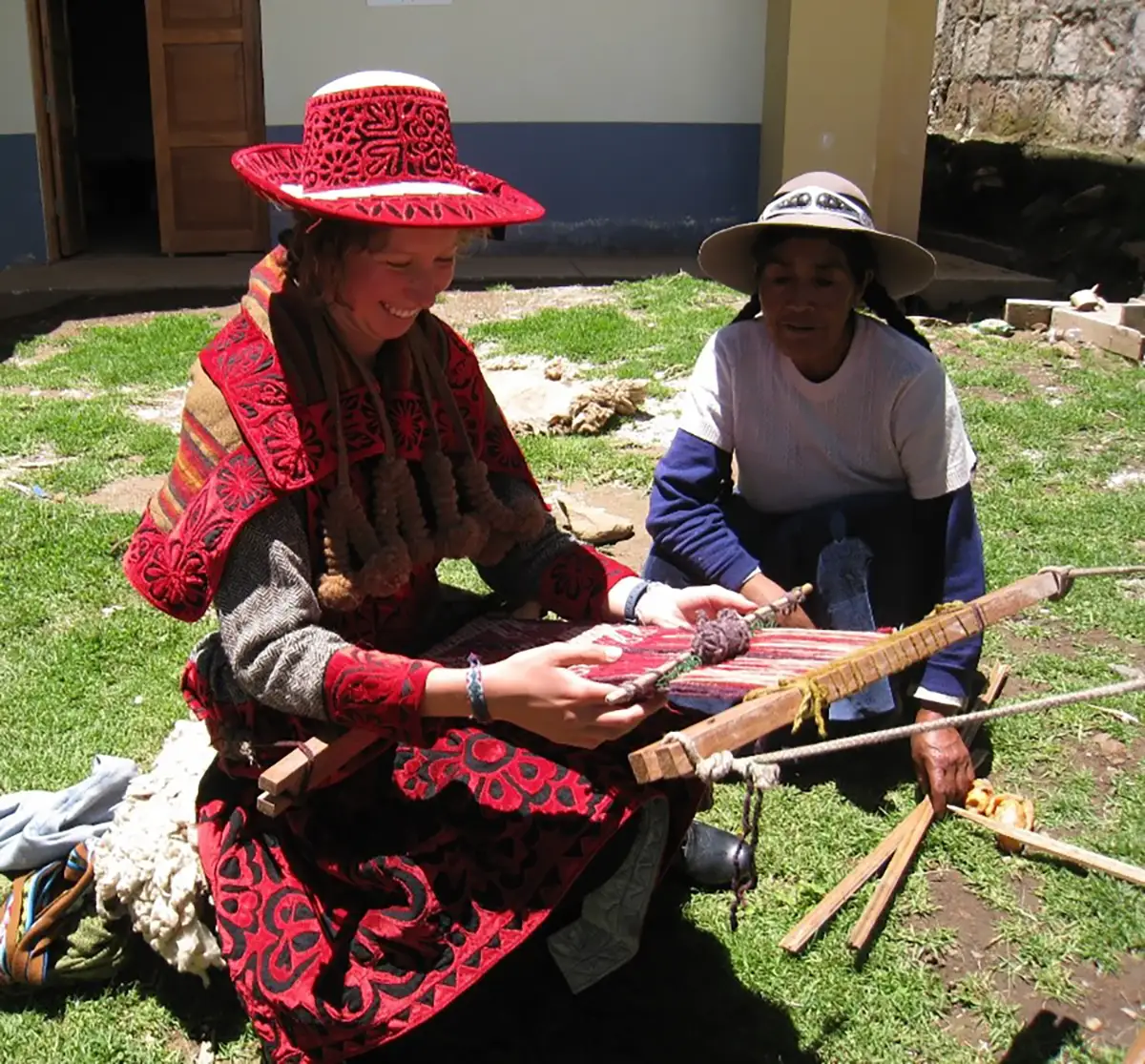
Master weavers keep ancient Andean techniques alive and also offer weaving courses, allowing visitors to learn directly from these skilled artisans. Photo by Centro de Textiles Tradicionales del Cusco .
The Museo Histórico Regional offers a fascinating insight into the region’s history, showcasing artifacts and exhibitions that trace the cultural evolution of the area from pre-Columbian times through the colonial era and into modern-day Peru.
Housed in a colonial building, the museum provides a rich overview of Cusco's role as the heart of the Inca Empire, with a focus on its historical, artistic, and cultural heritage. Visitors can explore displays of Incan pottery, textiles, and tools, as well as colonial-era paintings and documents. The museum also highlights the impact of Spanish colonization and the fusion of indigenous and European traditions.
This museum is a great stop for history enthusiasts looking to deepen their understanding of Cusco's significance in both Andean and global history. It offers a well-rounded perspective, with its artifacts providing tangible connections to the city's rich and layered past. Find it here !
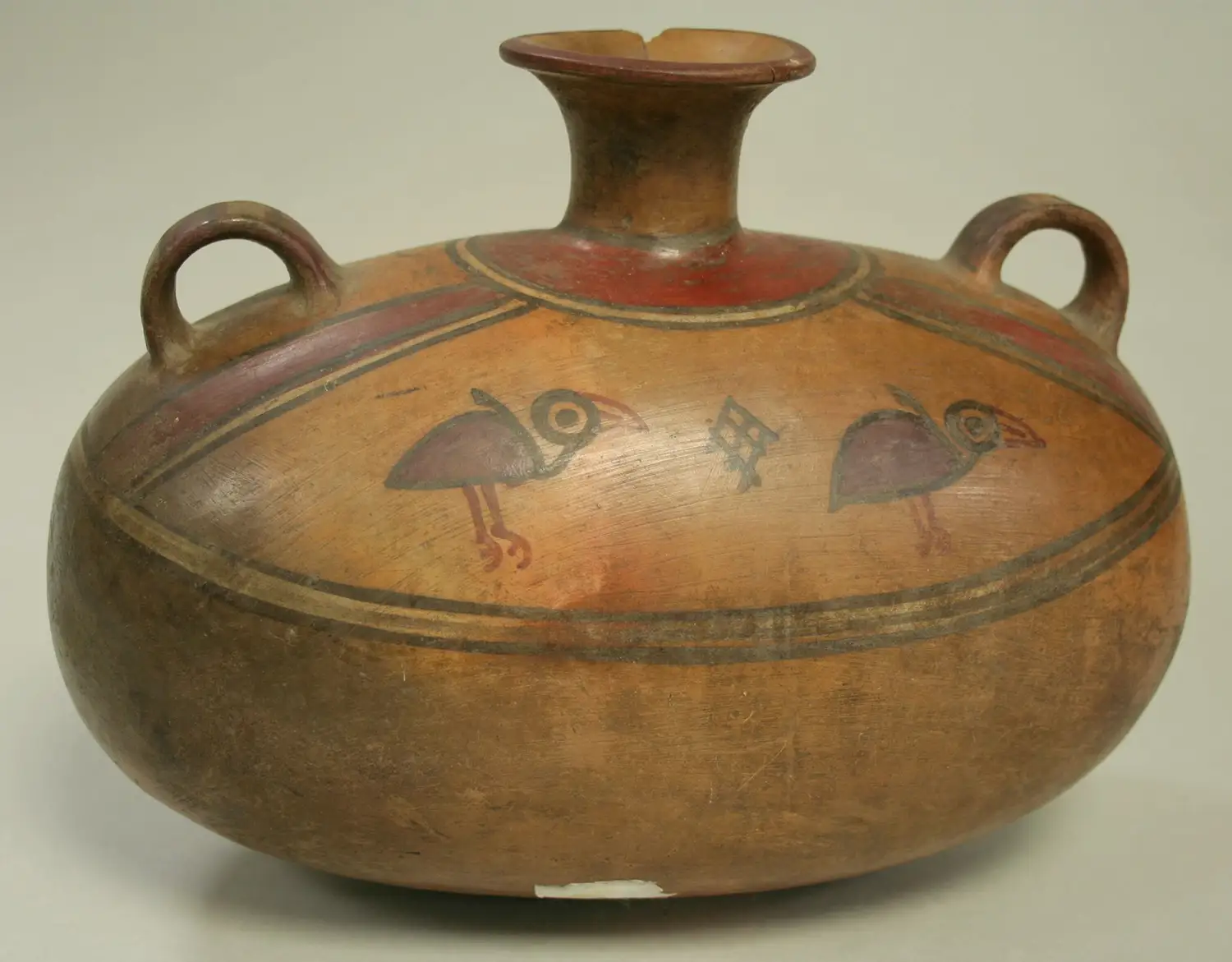
Incan pottery reflects the artistry and symbolism of an ancient civilization, with intricate designs and forms that capture the spirit of the Andes. Photo by Metropolitan Museum of Art, under the CC0 license , via Wikimedia Commons .
Centro Artesanal Cusco is one of the city’s largest and most popular artisan markets, located just a short walk from the historic center. This vibrant market is filled with a wide range of locally crafted goods, offering an authentic Peruvian shopping experience. Here, you’ll find stalls selling colorful textiles, alpaca wool clothing, handwoven rugs, jewelry, ceramics, and souvenirs, all showcasing the artistry of Cusco's skilled artisans.
Beyond shopping, Centro Artesanal Cusco is an ideal place to engage with local culture. Many vendors are happy to share the stories and traditional techniques behind their work, giving visitors a deeper appreciation for the heritage of the region.
With its lively atmosphere and endless selection of unique, handcrafted items, the market is a must-visit for those looking to bring a piece of Peru home with them.
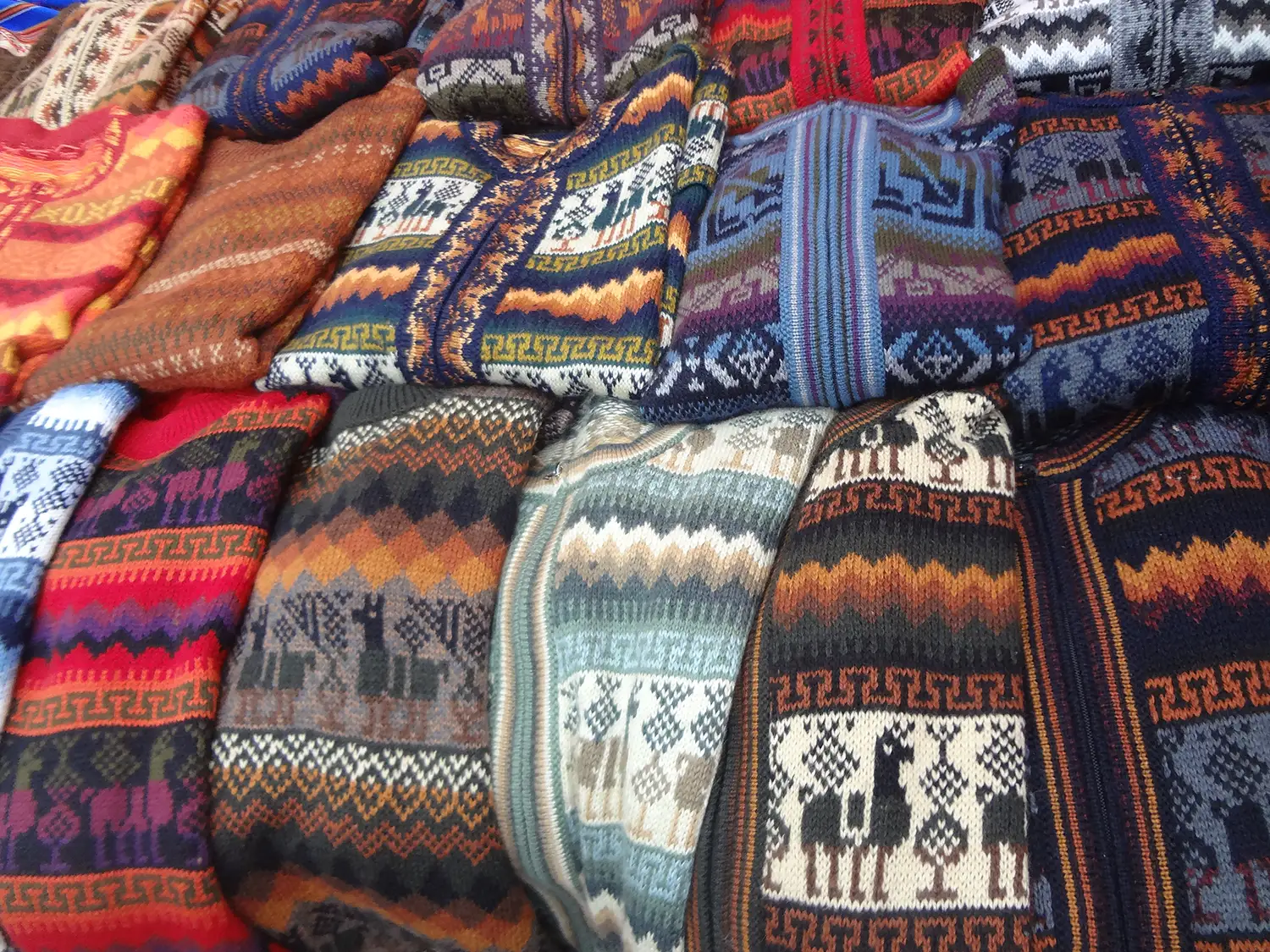
Found in Centro Artesanal Cusco, alpaca wool clothing blends warmth, softness, and tradition, crafted from the Andes’ finest fibers for comfort and style. Photo by David Adam Kess, under the CC BY-SA 3.0 < https://creativecommons.org/licenses/by-sa/3.0 > license, via Wikimedia Commons .
Mercado de San Blas is a charming, smaller market located in the bohemian neighborhood of San Blas, known for its artistic vibe and cobblestone streets.
Unlike the more commercialized markets in Cusco, this market offers a more intimate and authentic experience. It's a great place to immerse yourself in local life, as you’ll find everything from fresh produce, meats, and spices to handmade crafts and souvenirs.
Visitors can stroll through the market and find unique handmade jewelry, pottery, textiles, and other traditional Andean crafts, often created by local artisans from the surrounding San Blas community. It’s also an ideal spot to try local snacks, such as empanadas or fresh fruit juices, while observing the colorful, daily hustle and bustle of the area. The market's location, perched above the main square, adds to its charm, making it a perfect place to explore after discovering the artistic neighborhood of San Blas.
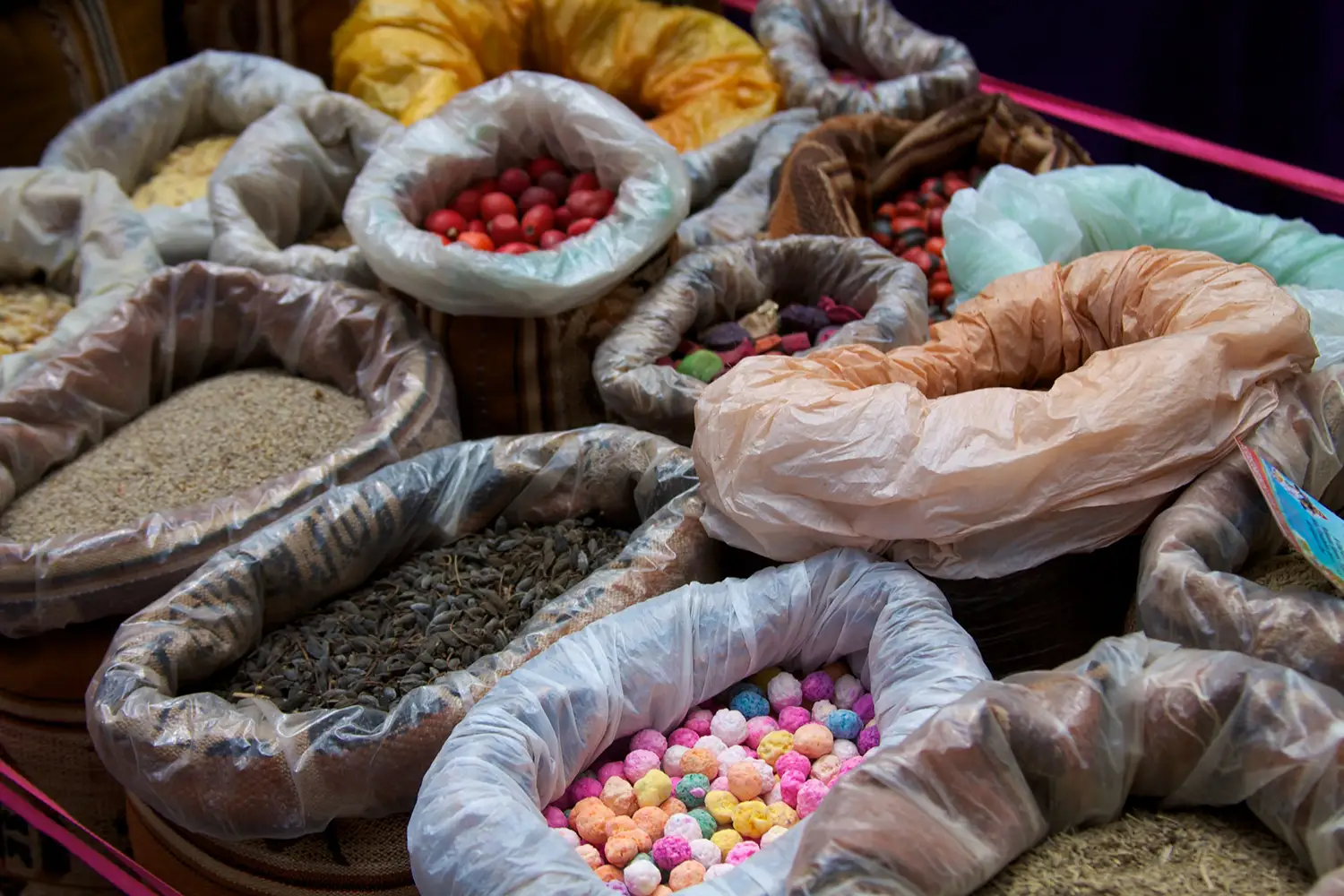
The flavors of San Blas Market, where local snacks and dry goods offer a taste of Cusco’s authentic culinary traditions. Photo by McKay Savage from London, UK, under the CC BY 2.0 < https://creativecommons.org/licenses/by/2.0 > license, via Wikimedia Commons .
Pisac Market is one of the most popular and vibrant markets in the Sacred Valley of Peru, located in the town of Pisac, just an hour's drive from Cusco. The market is famous for its traditional Andean crafts, fresh produce, and artisanal goods, making it a must-visit for anyone seeking authentic local products.
The market is split into two main sections: the craft market and the food market. The craft market is a treasure trove of handmade textiles, jewelry, pottery, wooden carvings, and other traditional souvenirs. Visitors can find high-quality alpaca wool products, including scarves, hats, and blankets, as well as intricate jewelry made with local materials like silver and gemstones. It's a perfect spot to shop for unique gifts and souvenirs.
The food market is a vibrant space where locals gather to buy fresh fruits, vegetables, herbs, meats, and spices. Here, you can also sample local snacks. The market is also a great place to experience the bustling daily life of the Andean community, with friendly vendors eager to share their products and stories.

Vibrant colors and handcrafted treasures await at Pisac Market, where local artisans showcase textiles, jewelry, and fresh produce in the heart of the Sacred Valley. Photo by Christoph Strässler, under the CC BY-SA 2.0 < https://creativecommons.org/licenses/by-sa/2.0 > license, via Wikimedia Commons .
Rooftop Sunset and Local Flavors in Cusco offers a memorable way to unwind after a day of exploring, combining stunning views with the opportunity to savor traditional Peruvian cuisine.
Start by heading to a local rooftop restaurant or café, where you can relax with a drink in hand as the sun sets over the Andean mountains or the historic city of Cusco. Many rooftops in the area offer breathtaking panoramic views, allowing you to witness the colors of the sky transforming as the sun dips below the horizon.
As you enjoy the view, consider sampling some of the region’s signature dishes. For a true taste of Peruvian culinary tradition, try cuy (guinea pig), a popular delicacy in the Andes, or savor a hearty lomo saltado, a stir-fry of marinated beef, onions, tomatoes, and French fries. Pair these with a refreshing pisco sour, the national cocktail made from pisco, lime, egg white, and bitters.
In the heart of Cusco, a rooftop sunset paired with local flavors offers a perfect way to end your day with a sense of tranquility and cultural immersion. Here are some of the best spots:
Limbus Restobar is a trendy rooftop bar in Cusco’s San Blas neighborhood, offering spectacular panoramic views of the city. Known for its creative cocktails and modern twists on Peruvian cuisine, it’s a perfect spot to enjoy a sunset while savoring flavorful dishes and drinks in a vibrant atmosphere.
ViewHouse Resto Bar is a chic rooftop venue in Cusco that combines stunning city views with a warm, inviting atmosphere. It offers a mix of traditional Peruvian and international dishes, along with refreshing cocktails, making it an ideal spot to unwind and enjoy the sunset.
For a cooking class experience with breathtaking views, this spot is unmatched! Rooftop Kitchen Peru offers a unique blend of culinary experience and breathtaking views. Learn to cook traditional Peruvian dishes while overlooking Cusco’s scenic cityscape. This hands-on activity includes professional guidance, access to fresh local ingredients, and a memorable meal you prepare yourself.
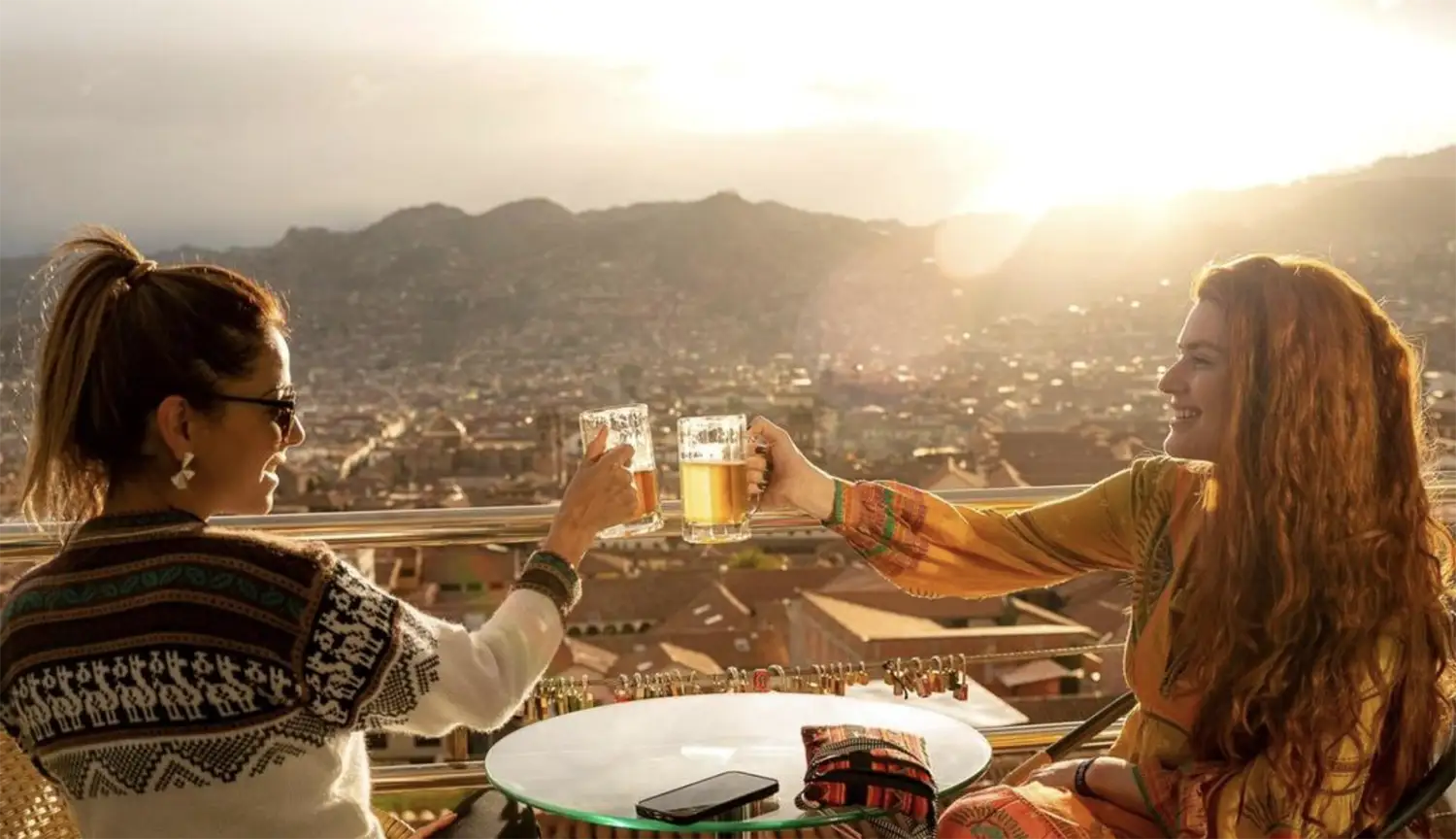
Elevate your experience at Limbus Restobar, where local flavors and stunning panoramic views of Cusco come together for an unforgettable evening. Photo by Limbus Restobar on Instagram .
By following these tips, you can make the most of your time in Cusco while ensuring a comfortable and enjoyable experience.
Cusco sits at 3,400 meters (11,150 feet) above sea level, so it's important to take it easy. Drink plenty of water, avoid heavy meals, and rest when needed. Avoiding alcohol and smoking is highly recommended, especially if you’re susceptible to altitude sickness.
Due to the high altitude, you may experience dehydration more easily. Carry a water bottle and hydrate frequently.
Cusco’s cobblestone streets and hilly terrain can be challenging. Comfortable walking shoes with good grip are essential for exploring the city.
Cusco’s weather can change rapidly, with warm days and chilly nights. Dress in layers and bring a light jacket for the evening.
The sun can be intense, even at high altitudes. Use sunscreen, sunglasses, and a hat to protect yourself from UV rays.
While many businesses accept cards, it's best to carry cash, especially for markets and small vendors. ATMs are widely available, but it's a good idea to withdraw money in advance.
Cusco is a city rich in tradition. Be mindful of local customs, particularly when visiting sacred sites. Always ask before taking photos, especially of indigenous people.
If you plan to trek or visit nearby areas, pack light and only bring essentials. Many treks, including the Inca Trail, require permits that can only be obtained in advance.
Cusco’s compact size makes it easy to explore on foot. However, taxis are readily available for short rides, and local buses can take you to destinations a bit further out. If you’re heading to nearby attractions, it’s a good idea to book transportation through your hotel or a trusted tour operator.
Cusco is filled with artisan markets, particularly in the San Pedro Market and the bustling Plaza de Armas area. You can find everything from handmade textiles, jewelry, and pottery to authentic alpaca wool scarves. Bargaining is common, so don’t be afraid to negotiate prices.
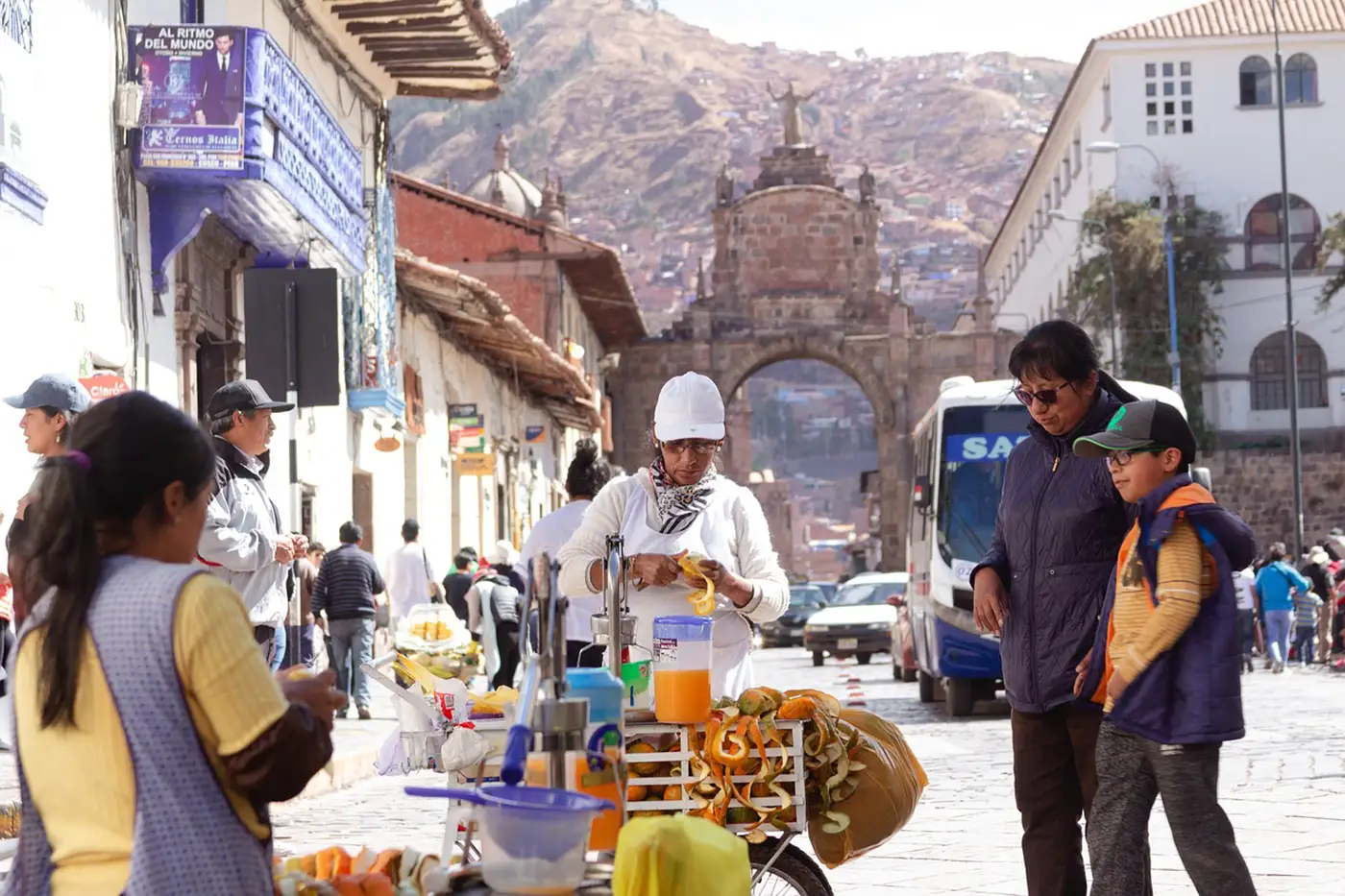
Embrace the heart of Cusco with respect for its rich traditions and vibrant culture—a journey of understanding and connection. Photo by _Dianna on Pixabay .
As your adventure in Cusco comes to a close, it’s essential to plan for a smooth departure. Here are some practical tips to ensure your last moments in the city are stress-free and enjoyable:
Cusco’s Alejandro Velasco Astete International Airport is small but can get busy, especially during peak travel hours. Aim to arrive two hours before a domestic flight or three hours for an international flight to allow time for check-in, security, and potential delays caused by weather, which can be common in the region.
If you have time before heading to the airport, take advantage of Cusco’s many markets and shops to pick up souvenirs or gifts:
Stock up on local treats to enjoy during your travels:
On your way to the airport, take a moment to admire the city’s charming streets and mountain views one last time. Cusco’s magic will stay with you long after you leave. Safe travels!
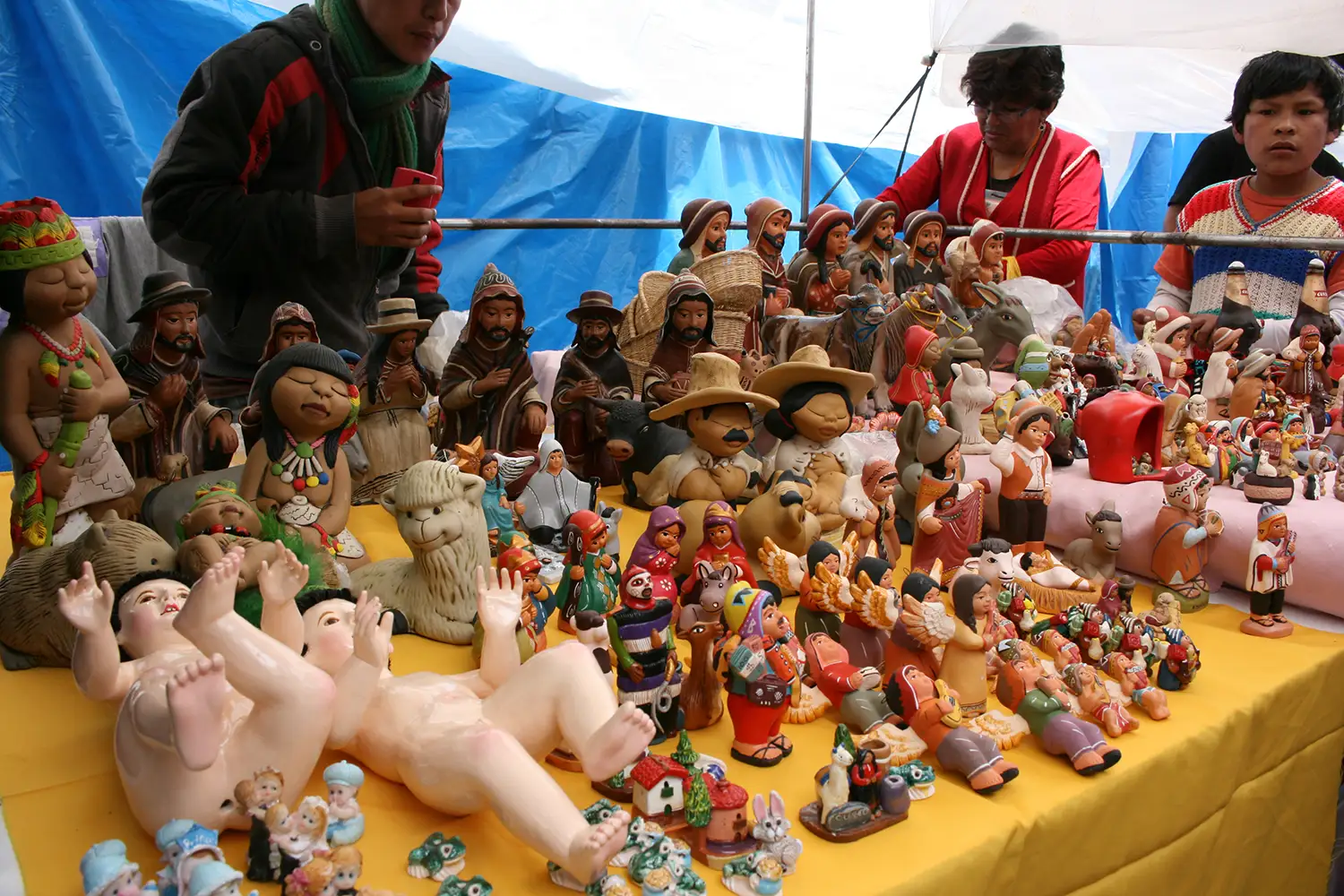
Don’t leave Cusco without grabbing a few unique treasures to remember your adventure! Photo by Renate Zindel, CC BY 2.0 < https://creativecommons.org/licenses/by/2.0 >, via Wikimedia Commons .
Cusco is more than just a gateway to Machu Picchu—it’s a city steeped in history, culture, and natural beauty that captivates at every turn. In just 48 hours, you can immerse yourself in its vibrant markets, explore ancient Inca ruins, and savor the rich flavors of Peruvian cuisine. Whether you’re admiring a breathtaking rooftop sunset, learning traditional crafts, or wandering its cobblestone streets, Cusco offers an unforgettable blend of past and present. As your journey continues, you’ll carry with you the warmth of its people, the stories of its heritage, and memories that will last a lifetime. Safe travels!


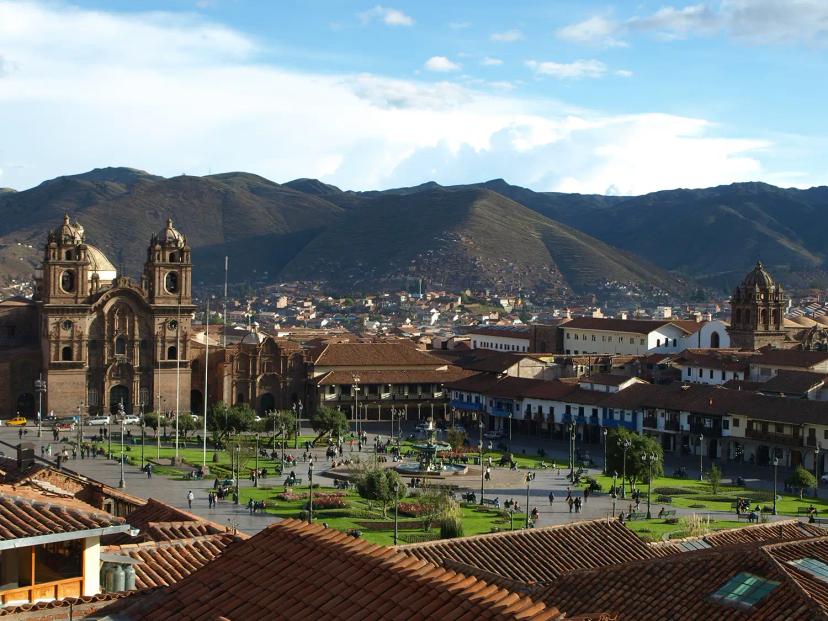
Email: [email protected]
Sign up to receive our newsletter for great articles, stunning photos, and special deals.